Nanofiltration for Arsenic Removal: Challenges, Recent Developments, and Perspectives
Abstract
1. Introduction
2. Arsenic in Natural Water: Sources, Speciation, and Mobility
3. Toxicity and Health Risk of Chronic Arsenic Exposure
4. Nanofiltration for Arsenic Removal
4.1. Arsenic Removal Technologies from Drinking Water
4.2. Nanofiltration Process
4.3. Rejection Mechanism of Arsenic through NF Membranes
4.4. NF Membranes for Arsenic Removal
4.4.1. Commercial NF Membranes for As Removal
4.4.2. Synthesized and Modified NF Membranes for As Removal
5. Nanofiltration Membrane Fabrication Process: Limitations and Future Prospects
5.1. Electrospinning: An Emerging Synthesis Technique of NF Membranes
5.2. Graphene-Based Materials for Arsenic Removal
6. Influential Parameters on Arsenic Removal Efficiency
6.1. Effect of Arsenic Concentration of Feed Water
6.2. Effect of Co-Occurring Inorganic Solutes on As Removal
6.3. Effect of Feed Water pH
6.4. Effect of Applied Pressure
6.5. Effect of Temperature
7. Current Challenges and Limitations
8. Conclusions and Outlook
Author Contributions
Funding
Acknowledgments
Conflicts of Interest
References
- Grafton, R.Q.; Horne, J. Water markets in the murray-darling basin. Agric. Water Manag. 2014, 145, 61–71. [Google Scholar] [CrossRef]
- World Water Assessment Programme; UN-Water. Water in a Changing World; Earthscan: London, UK, 2009; Volume 1. [Google Scholar]
- Bagla, P.; Kaiser, J. India’s spreading health crisis draws global arsenic experts. Science 1996, 274, 174–175. [Google Scholar] [CrossRef] [PubMed]
- World Health Organization. Guidelines for Drinking-Water Quality, 4th ed.; World Health Organization: Geneva, Switzerland, 2011. [Google Scholar]
- Adler, R.W. US Environmental Protection Agency’s new Waters of the United States Rule: Connecting law and science. Freshw. Sci. 2015, 34, 1595–1600. [Google Scholar] [CrossRef]
- Health Canada. Guidelines for Canadian Drinking Water Quality—Summary Table. In Water and Air Quality Bureau, Healthy Environments and Consumer Safety Branch; Health Canada: Ottawa, ON, Canada, 2014. [Google Scholar]
- Instruments, S. European Union (Drinking Water) Regulations; Union, E., Ed.; Electronic Irish Statute Book: Dublin, Ireland, 2014. [Google Scholar]
- Von Ehrenstein, O.; Guha Mazumder, D.; Hira-Smith, M.; Ghosh, N.; Yuan, Y.; Windham, G.; Ghosh, A.; Haque, R.; Lahiri, S.; Kalman, D.; et al. Pregnancy outcomes, infant mortality, and arsenic in drinking water in west bengal, india. Am. J. Epidemiol. 2006, 163, 662–669. [Google Scholar] [CrossRef] [PubMed]
- Krishna, A.K.; Satyanarayanan, M.; Govil, P.K. Assessment of heavy metal pollution in water using multivariate statistical techniques in an industrial area: A case study from patancheru, medak district, andhra pradesh, India. J. Hazard. Mater. 2009, 167, 366–373. [Google Scholar] [CrossRef]
- Buschmann, J.; Berg, M.; Stengel, C.; Winkel, L.; Sampson, M.L.; Trang, P.T.K.; Viet, P.H. Contamination of drinking water resources in the mekong delta floodplains: Arsenic and other trace metals pose serious health risks to population. Environ. Int. 2008, 34, 756–764. [Google Scholar] [CrossRef]
- Wade, T.; Xia, Y.; Wu, K.; Li, Y.; Ning, Z.; Le, X.C.; Lu, X.; Feng, Y.; He, X.; Mumford, J. Increased mortality associated with well-water arsenic exposure in inner mongolia, china. Int. J. Environ. Res. Pub. Health 2009, 6, 1107–1123. [Google Scholar] [CrossRef]
- Xia, Y.; Wade, T.; Wu, K.; Li, Y.; Ning, Z.; Le, X.C.; Chen, B.; Feng, Y.; Mumford, J.; He, X. Well water arsenic exposure, arsenic induced skin-lesions and self-reported morbidity in inner mongolia. Int. J. Environ. Res. Pub. Health 2009, 6, 1010–1025. [Google Scholar] [CrossRef]
- Mosaferi, M.; Yunesian, M.; Dastgiri, S.; Mesdaghinia, A.; Esmailnasab, N. Prevalence of skin lesions and exposure to arsenic in drinking water in iran. Sci. Total Environ. 2008, 390, 69–76. [Google Scholar] [CrossRef]
- Ning, R.Y. Arsenic removal by reverse osmosis. Desalination 2002, 143, 237–241. [Google Scholar] [CrossRef]
- Ćavar, S.; Klapec, T.; Grubešić, R.J.; Valek, M. High exposure to arsenic from drinking water at several localities in eastern croatia. Sci. Total. Environ. 2005, 339, 277–282. [Google Scholar] [CrossRef] [PubMed]
- Armienta, M.; Segovia, N. Arsenic and fluoride in the groundwater of mexico. Environ. Geochem. Health 2008, 30, 345–353. [Google Scholar] [CrossRef] [PubMed]
- Bundschuh, J.; García, M. Rural Latin America–A Forgotten Part of the Global Groundwater Arsenic Problem. In Groundwater for Sustainable Development: Problems, Perspectives and Challenges; Leiden Balkema Publisher: London, UK, 2008; pp. 311–321. [Google Scholar]
- Amini, M.; Abbaspour, K.C.; Berg, M.; Winkel, L.; Hug, S.J.; Hoehn, E.; Yang, H.; Johnson, C.A. Statistical modeling of global geogenic arsenic contamination in groundwater. Environ. Sci. Technol. 2008, 42, 3669–3675. [Google Scholar] [CrossRef] [PubMed]
- Chakraborti, D.; Sengupta, M.K.; Rahman, M.M.; Ahamed, S.; Chowdhury, U.K.; Hossain, A.; Mukherjee, S.C.; Pati, S.; Saha, K.C.; Dutta, R. Groundwater arsenic contamination and its health effects in the ganga-meghna-brahmaputra plain. J. Environ. Monit. 2004, 6, 74. [Google Scholar] [CrossRef]
- Chowdhury, S.; Mazumder, M.J.; Al-Attas, O.; Husain, T. Heavy metals in drinking water: Occurrences, implications, and future needs in developing countries. Sci. Total. Environ. 2016, 569, 476–488. [Google Scholar] [CrossRef]
- Newhouse, D.; Suarez-Becerra, P.; Evans, M.C. New estimates of extreme poverty for children. The World Bank, 2 October 2016. [Google Scholar]
- Hashim, M.A.; Mukhopadhyay, S.; Sahu, J.N.; Sengupta, B. Remediation technologies for heavy metal contaminated groundwater. J. Environ. Manag. 2011, 92, 2355–2388. [Google Scholar] [CrossRef]
- Amin, M.N.; Kaneco, S.; Kitagawa, T.; Begum, A.; Katsumata, H.; Suzuki, T.; Ohta, K. Removal of arsenic in aqueous solutions by adsorption onto waste rice husk. Ind. Eng. Chem. Res. 2006, 45, 8105–8110. [Google Scholar] [CrossRef]
- Hao, L.; Liu, M.; Wang, N.; Li, G. A critical review on arsenic removal from water using iron-based adsorbents. RSC Adv. 2018, 8, 39545–39560. [Google Scholar] [CrossRef]
- Sigdel, A.; Lim, J.; Park, J.; Kwak, H.; Min, S.; Kim, K.; Lee, H.; Nahm, C.H.; Park, P.-K. Immobilization of hydrous iron oxides in porous alginate beads for arsenic removal from water. Environ. Sci. Water Res. Technol. 2018, 4, 1114–1123. [Google Scholar] [CrossRef]
- Budinova, T.; Petrov, N.; Razvigorova, M.; Parra, J.; Galiatsatou, P. Removal of arsenic (iii) from aqueous solution by activated carbons prepared from solvent extracted olive pulp and olive stones. Ind. Eng. Chem. Res. 2006, 45, 1896–1901. [Google Scholar] [CrossRef]
- Chen, H.; Sharma, S.K.; Sharma, P.R.; Yeh, H.; Johnson, K.; Hsiao, B.S. Arsenic (iii) removal by nanostructured dialdehyde cellulose–cysteine microscale and nanoscale fibers. ACS Omega 2019, 4, 22008–22020. [Google Scholar] [CrossRef] [PubMed]
- Sharma, P.R.; Sharma, S.K.; Antoine, R.; Hsiao, B.S. Efficient removal of arsenic using zinc oxide nanocrystal-decorated regenerated microfibrillated cellulose scaffolds. ACS Sustain. Chem. Eng. 2019, 7, 6140–6151. [Google Scholar] [CrossRef]
- Liu, T.; Zhang, Z.; Wang, Z.; Wang, Z.-L.; Bush, R. Highly efficient and rapid removal of arsenic (iii) from aqueous solutions by nanoscale zero-valent iron supported on a zirconium 1, 4-dicarboxybenzene metal–organic framework (uio-66 mof). RSC Adv. 2019, 9, 39475–39487. [Google Scholar] [CrossRef]
- Maity, S.; Naskar, N.; Lahiri, S.; Ganguly, J. Polysaccharide-derived hydrogel water filter for the rapid and selective removal of arsenic. Environ. Sci. Water Res. Technol. 2019, 5, 1318–1327. [Google Scholar] [CrossRef]
- Bank, W. World Bank Country and Lending Groups; The World Bank Group: Washington, DC, USA, 2017. [Google Scholar]
- Litter, M.I.; Ingallinella, A.M.; Olmos, V.; Savio, M.; Difeo, G.; Botto, L.; Torres, E.M.F.; Taylor, S.; Frangie, S.; Herkovits, J. Arsenic in argentina: Technologies for arsenic removal from groundwater sources, investment costs and waste management practices. Sci. Total Environ. 2019, 690, 778–789. [Google Scholar] [CrossRef]
- Sullivan, C.; Tyrer, M.; Cheeseman, C.R.; Graham, N.J. Disposal of water treatment wastes containing arsenic—A review. Sci. Total Environ. 2010, 408, 1770–1778. [Google Scholar] [CrossRef]
- Pal, P. Groundwater Arsenic Remediation: Treatment Technology and Scale Up; Butterworth-Heinemann: Oxford, UK, 2015. [Google Scholar]
- Criscuoli, A.; Figoli, A. Pressure-driven and thermally-driven membrane operations for the treatment of arsenic-contaminated waters: A comparison. J. Hazard. Mater. 2019, 370, 147–155. [Google Scholar] [CrossRef]
- Smedley, P.L.; Kinniburgh, D.G. A review of the source, behaviour and distribution of arsenic in natural waters. Appl. Geochem. 2002, 17, 517–568. [Google Scholar] [CrossRef]
- Shankar, S.; Shanker, U. Arsenic contamination of groundwater: A review of sources, prevalence, health risks, and strategies for mitigation. Sci. World J. 2014, 2014, 304524. [Google Scholar] [CrossRef]
- Hoque, M.A.; Burgess, W.G.; Ahmed, K.M. Integration of aquifer geology, groundwater flow and arsenic distribution in deltaic aquifers–a unifying concept. Hydrol. Process. 2017, 31, 2095–2109. [Google Scholar] [CrossRef]
- Nriagu, J.; Bhattacharya, P.; Mukherjee, A.; Bundschuh, J.; Zevenhoven, R.; Loeppert, R. Arsenic in soil and groundwater: An overview. Trace Metals Contam. Environ. 2007, 9, 3–60. [Google Scholar]
- Mukherjee, A.; Sengupta, M.K.; Hossain, M.A.; Ahamed, S.; Das, B.; Nayak, B.; Lodh, D.; Rahman, M.M.; Chakraborti, D. Arsenic contamination in groundwater: A global perspective with emphasis on the asian scenario. J. Health Popul. Nutr. 2006, 24, 142–163. [Google Scholar] [PubMed]
- Nordstrom, D.K. Worldwide Occurrences of Arsenic in Ground Water; American Association for the Advancement of Science: Washington, DC, USA, 2002. [Google Scholar]
- Chakraborti, D.; Rahman, M.M.; Das, B.; Murrill, M.; Dey, S.; Mukherjee, S.C.; Dhar, R.K.; Biswas, B.K.; Chowdhury, U.K.; Roy, S. Status of groundwater arsenic contamination in bangladesh: A 14-year study report. Water Res. 2010, 44, 5789–5802. [Google Scholar] [CrossRef] [PubMed]
- Gunduz, O.; Simsek, C.; Hasozbek, A. Arsenic pollution in the groundwater of simav plain, turkey: Its impact on water quality and human health. Water Air Soil Pollut. 2010, 205, 43. [Google Scholar] [CrossRef]
- Bundschuh, J.; Litter, M.I.; Parvez, F.; Román-Ross, G.; Nicolli, H.B.; Jean, J.-S.; Liu, C.-W.; López, D.; Armienta, M.A.; Guilherme, L.R. One century of arsenic exposure in latin america: A review of history and occurrence from 14 countries. Sci. Total Environ. 2012, 429, 2–35. [Google Scholar] [CrossRef]
- Sthiannopkao, S.; Kim, K.; Sotham, S.; Choup, S. Arsenic and manganese in tube well waters of prey veng and kandal provinces, cambodia. Appl. Geochem. 2008, 23, 1086–1093. [Google Scholar] [CrossRef]
- Rahman, M.M.; Naidu, R.; Bhattacharya, P. Arsenic contamination in groundwater in the southeast asia region. Environ. Geochem. Health 2009, 31, 9–21. [Google Scholar] [CrossRef]
- Das, S.; Jean, J.-S.; Kar, S. Bioaccessibility and health risk assessment of arsenic in arsenic-enriched soils, central india. Ecotoxicol. Environ. Saf. 2013, 92, 252–257. [Google Scholar] [CrossRef]
- Srivastava, S.; Sharma, Y.K. Arsenic occurrence and accumulation in soil and water of eastern districts of uttar pradesh, india. Environ. Monit. Assess. 2013, 185, 4995–5002. [Google Scholar] [CrossRef]
- Khan, M.A.; Ho, Y.-S. Arsenic in drinking water: A review on toxicological effects, mechanism of accumulation and remediation. Asian J. Chem. 2011, 23, 1889. [Google Scholar]
- Cutler, W.G.; Brewer, R.C.; El-Kadi, A.; Hue, N.V.; Niemeyer, P.G.; Peard, J.; Ray, C. Bioaccessible arsenic in soils of former sugar cane plantations, island of hawaii. Sci. Total Environ. 2013, 442, 177–188. [Google Scholar] [CrossRef]
- Twarakavi, N.K.C.; Kaluarachchi, J.J. Arsenic in the shallow ground waters of conterminous United States: Assessment, health risks, and costs for mcl compliance 1. J. Am. Water Resour. Assoc. 2006, 42, 275–294. [Google Scholar] [CrossRef]
- Ritchie, V.J.; Ilgen, A.G.; Mueller, S.H.; Trainor, T.P.; Goldfarb, R.J. Mobility and chemical fate of antimony and arsenic in historic mining environments of the kantishna hills district, denali national park and preserve, alaska. Chem. Geol. 2013, 335, 172–188. [Google Scholar] [CrossRef]
- Arain, M.; Kazi, T.; Baig, J.; Jamali, M.; Afridi, H.; Shah, A.; Jalbani, N.; Sarfraz, R. Determination of arsenic levels in lake water, sediment, and foodstuff from selected area of sindh, pakistan: Estimation of daily dietary intake. Food Chem. Toxicol. 2009, 47, 242–248. [Google Scholar] [CrossRef]
- Baeyens, W.; de Brauwere, A.; Brion, N.; De Gieter, M.; Leermakers, M. Arsenic speciation in the river zenne, belgium. Sci. Total Environ. 2007, 384, 409–419. [Google Scholar] [CrossRef] [PubMed]
- Barats, A.; Féraud, G.; Potot, C.; Philippini, V.; Travi, Y.; Durrieu, G.; Dubar, M.; Simler, R. Naturally dissolved arsenic concentrations in the alpine/mediterranean var river watershed (France). Sci. Total Environ. 2014, 473, 422–436. [Google Scholar] [CrossRef]
- Singh, M.; Singh, A.K.; Srivastava, N.; Singh, S.; Chowdhary, A. Arsenic mobility in fluvial environment of the ganga plain, northern india. Environ. Earth Sci. 2010, 59, 1703–1715. [Google Scholar] [CrossRef]
- Reynolds, J.; Naylor, D.; Fendorf, S. Arsenic sorption in phosphate-amended soils during flooding and subsequent aeration. Soil Sci. Soc. J. 1999, 63, 1149–1156. [Google Scholar] [CrossRef]
- Wang, S.; Mulligan, C.N. Occurrence of arsenic contamination in canada: Sources, behavior and distribution. Sci. Total Environ. 2006, 366, 701–721. [Google Scholar] [CrossRef]
- Singh, N.; Kumar, D.; Sahu, A.P. Arsenic in the environment: Effects on human health and possible prevention. J. Environ. Biol. 2007, 28, 359. [Google Scholar]
- Wong, W.; Wong, H.; Badruzzaman, A.B.M.; Goh, H.; Zaman, M. Recent advances in exploitation of nanomaterial for arsenic removal from water: A review. Nanotechnology 2016, 28, 042001. [Google Scholar] [CrossRef] [PubMed]
- Saha, J.C.; Dikshit, A.K.; Bandyopadhyay, M.; Saha, K.C. A review of arsenic poisoning and its effects on human health. Crit. Rev. Environ. Sci. Technol. 1999, 29, 281–313. [Google Scholar] [CrossRef]
- Khairul, I.; Wang, Q.Q.; Jiang, Y.H.; Wang, C.; Naranmandura, H. Metabolism, toxicity and anticancer activities of arsenic compounds. Oncotarget 2017, 8, 23905. [Google Scholar] [CrossRef] [PubMed]
- Gordon, J.; Quastel, G. Effect of organic arsenicals on enzyme system. Biochem. J. 1948, 42, 337–350. [Google Scholar] [CrossRef]
- Yoshida, T.; Yamauchi, H.; Fan Sun, G. Chronic health effects in people exposed to arsenic via the drinking water: Dose–response relationships in review. Toxicol. Appl. Pharmacol. 2004, 198, 243–252. [Google Scholar] [CrossRef]
- Zhang, T.-C.; Schmitt, M.T.; Mumford, J.L. Effects of arsenic on telomerase and telomeres in relation to cell proliferation and apoptosis in human keratinocytes and leukemia cells in vitro. Carcinogenesis 2003, 24, 1811–1817. [Google Scholar] [CrossRef]
- Chakraborti, D.; Mukherjee, S.C.; Pati, S.; Sengupta, M.K.; Rahman, M.M.; Chowdhury, U.K.; Lodh, D.; Chanda, C.R.; Chakraborti, A.K.; Basu, G.K. Arsenic groundwater contamination in middle ganga plain, bihar, india: A future danger? Environ. Health Perspect. 2003, 111, 1194–1201. [Google Scholar] [CrossRef]
- Sun, H.-J.; Rathinasabapathi, B.; Wu, B.; Luo, J.; Pu, L.-P.; Ma, L.Q. Arsenic and selenium toxicity and their interactive effects in humans. Environ. Int. 2014, 69, 148–158. [Google Scholar] [CrossRef]
- Bissen, M.; Frimmel, F.H. Arsenic—A review. Part ii: Oxidation of arsenic and its removal in water treatment. Acta Hydrochim. Et Hydrobiol. 2003, 31, 97–107. [Google Scholar] [CrossRef]
- Pallier, V.; Feuillade-Cathalifaud, G.; Serpaud, B.; Bollinger, J.-C. Effect of organic matter on arsenic removal during coagulation/flocculation treatment. J. Coll. Sci. 2010, 342, 26–32. [Google Scholar] [CrossRef]
- Ungureanu, G.; Santos, S.; Boaventura, R.; Botelho, C. Arsenic and antimony in water and wastewater: Overview of removal techniques with special reference to latest advances in adsorption. J. Environ. Manag. 2015, 151, 326–342. [Google Scholar] [CrossRef] [PubMed]
- Lee, C.-G.; Alvarez, P.J.; Nam, A.; Park, S.-J.; Do, T.; Choi, U.-S.; Lee, S.-H. Arsenic (v) removal using an amine-doped acrylic ion exchange fiber: Kinetic, equilibrium, and regeneration studies. J. Hazard. Mater. 2017, 325, 223–229. [Google Scholar] [CrossRef] [PubMed]
- Nidheesh, P.; Singh, T.A. Arsenic removal by electrocoagulation process: Recent trends and removal mechanism. Chemosphere 2017, 181, 418–432. [Google Scholar] [CrossRef]
- Yoon, J.; Amy, G.; Chung, J.; Sohn, J.; Yoon, Y. Removal of toxic ions (chromate, arsenate, and perchlorate) using reverse osmosis, nanofiltration, and ultrafiltration membranes. Chemosphere 2009, 77, 228–235. [Google Scholar] [CrossRef] [PubMed]
- Nicomel, N.R.; Leus, K.; Folens, K.; Van Der Voort, P.; Du Laing, G. Technologies for arsenic removal from water: Current status and future perspectives. Int. J. Environ. Res. Pub. Health 2016, 13, 62. [Google Scholar] [CrossRef]
- Masscheleyn, P.H.; Delaune, R.D.; Patrick, W.H., Jr. Effect of redox potential and ph on arsenic speciation and solubility in a contaminated soil. Environ. Sci. Technol. 1991, 25, 1414–1419. [Google Scholar] [CrossRef]
- Sharma, V.K.; Dutta, P.K.; Ray, A.K. Review of kinetics of chemical and photocatalytical oxidation of arsenic (iii) as influenced by ph. J. Environ. Sci. Health Part A 2007, 42, 997–1004. [Google Scholar] [CrossRef]
- Ghurye, G.; Clifford, D. As (iii) oxidation using chemical and solid-phase oxidants. J. Am. Water Works Assoc. 2004, 96, 84–96. [Google Scholar] [CrossRef]
- Leupin, O.X.; Hug, S.J. Oxidation and removal of arsenic (iii) from aerated groundwater by filtration through sand and zero-valent iron. Water Res. 2005, 39, 1729–1740. [Google Scholar] [CrossRef]
- Pettine, M.; Campanella, L.; Millero, F. Arsenite oxidation by h2o2 in aqueous solutions. Geochim. Et Cosmochim. Acta 1999, 63, 2727–2735. [Google Scholar] [CrossRef]
- Dodd, M.C.; Vu, N.D.; Ammann, A.; Le, V.C.; Kissner, R.; Pham, H.V.; Cao, T.H.; Berg, M.; Von Gunten, U. Kinetics and mechanistic aspects of as (iii) oxidation by aqueous chlorine, chloramines, and ozone: Relevance to drinking water treatment. Environ. Sci. Technol. 2006, 40, 3285–3292. [Google Scholar] [CrossRef] [PubMed]
- Kim, M.-J.; Nriagu, J.; Haack, S. Carbonate ions and arsenic dissolution by groundwater. Environ. Sci. Technol. 2000, 34, 3094–3100. [Google Scholar] [CrossRef]
- Li, X.-J.; Liu, C.-S.; Li, F.-B.; Li, Y.-T.; Zhang, L.-J.; Liu, C.-P.; Zhou, Y.-Z. The oxidative transformation of sodium arsenite at the interface of α-mno2 and water. J. Hazard. Mater. 2010, 173, 675–681. [Google Scholar] [CrossRef] [PubMed]
- Neppolian, B.; Doronila, A.; Ashokkumar, M. Sonochemical oxidation of arsenic (iii) to arsenic (v) using potassium peroxydisulfate as an oxidizing agent. Water Res. 2010, 44, 3687–3695. [Google Scholar] [CrossRef]
- Sahai, N.; Lee, Y.J.; Xu, H.; Ciardelli, M.; Gaillard, J.-F. Role of fe (ii) and phosphate in arsenic uptake by coprecipitation. Geochim. Et Cosmochim. Acta 2007, 71, 3193–3210. [Google Scholar] [CrossRef]
- Katsoyiannis, I.A.; Zouboulis, A.I. Application of biological processes for the removal of arsenic from groundwaters. Water Res. 2004, 38, 17–26. [Google Scholar] [CrossRef]
- Lee, Y.; Um, I.-h.; Yoon, J. Arsenic (iii) oxidation by iron (vi)(ferrate) and subsequent removal of arsenic (v) by iron (iii) coagulation. Environ. Sci. Technol. 2003, 37, 5750–5756. [Google Scholar] [CrossRef]
- Battaglia-Brunet, F.; Dictor, M.C.; Garrido, F.; Crouzet, C.; Morin, D.; Dekeyser, K.; Clarens, M.; Baranger, P. An arsenic (iii)-oxidizing bacterial population: Selection, characterization, and performance in reactors. J. Appl. Microbiol. 2002, 93, 656–667. [Google Scholar] [CrossRef]
- Casiot, C.; Pedron, V.; Bruneel, O.; Duran, R.; Personné, J.; Grapin, G.; Drakidès, C.; Elbaz-Poulichet, F. A new bacterial strain mediating as oxidation in the fe-rich biofilm naturally growing in a groundwater fe treatment pilot unit. Chemosphere 2006, 64, 492–496. [Google Scholar] [CrossRef]
- Choong, T.S.; Chuah, T.; Robiah, Y.; Koay, F.G.; Azni, I. Arsenic toxicity, health hazards and removal techniques from water: An overview. Desalination 2007, 217, 139–166. [Google Scholar] [CrossRef]
- Malik, A.H.; Khan, Z.M.; Mahmood, Q.; Nasreen, S.; Bhatti, Z.A. Perspectives of low cost arsenic remediation of drinking water in pakistan and other countries. J. Hazard. Mater. 2009, 168, 1–12. [Google Scholar] [CrossRef] [PubMed]
- Hu, C.; Liu, H.; Chen, G.; Qu, J. Effect of aluminum speciation on arsenic removal during coagulation process. Sep. Purif. Technol. 2012, 86, 35–40. [Google Scholar] [CrossRef]
- Kartinen, E.O., Jr.; Martin, C.J. An overview of arsenic removal processes. Desalination 1995, 103, 79–88. [Google Scholar] [CrossRef]
- Asmel, N.K.; Yusoff, A.R.M.; Krishna, L.S.; Majid, Z.A.; Salmiati, S. High concentration arsenic removal from aqueous solution using nano-iron ion enrich material (niiem) super adsorbent. Chem. Eng. J. 2017, 317, 343–355. [Google Scholar] [CrossRef]
- Mohan, D.; Pittman, C.U., Jr. Arsenic removal from water/wastewater using adsorbents—A critical review. J. Hazard. Mater. 2007, 142, 1–53. [Google Scholar] [CrossRef]
- Sun, T.; Zhao, Z.; Liang, Z.; Liu, J.; Shi, W.; Cui, F. Efficient as (iii) removal by magnetic CuO-Fe3O4 nanoparticles through photo-oxidation and adsorption under light irradiation. J. Colloid Interface Sci. 2017, 495, 168–177. [Google Scholar] [CrossRef]
- Lin, T.-F.; Wu, J.-K. Adsorption of arsenite and arsenate within activated alumina grains: Equilibrium and kinetics. Water Res. 2001, 35, 2049–2057. [Google Scholar] [CrossRef]
- Singh, T.S.; Pant, K. Equilibrium, kinetics and thermodynamic studies for adsorption of as (iii) on activated alumina. Sep. Purif. Technol. 2004, 36, 139–147. [Google Scholar] [CrossRef]
- Thirunavukkarasu, O.; Viraraghavan, T.; Subramanian, K. Removal of arsenic in drinking water by iron oxide-coated sand and ferrihydrite—Batch studies. Water Qual. Res. J. 2001, 36, 55–70. [Google Scholar] [CrossRef]
- Banerjee, K.; Amy, G.L.; Prevost, M.; Nour, S.; Jekel, M.; Gallagher, P.M.; Blumenschein, C.D. Kinetic and thermodynamic aspects of adsorption of arsenic onto granular ferric hydroxide (gfh). Water Res. 2008, 42, 3371–3378. [Google Scholar] [CrossRef]
- Badruzzaman, M.; Westerhoff, P.; Knappe, D.R. Intraparticle diffusion and adsorption of arsenate onto granular ferric hydroxide (gfh). Water Res. 2004, 38, 4002–4012. [Google Scholar] [CrossRef]
- Islam, M.; Hossain, M.; Yousuf, A.; Subhan, M. Removal of arsenic from drinking water using bio-adsorbent. Proc. Pakistan Acad. Sci. 2007, 44, 157–164. [Google Scholar]
- Boddu, V.M.; Abburi, K.; Talbott, J.L.; Smith, E.D.; Haasch, R. Removal of arsenic (iii) and arsenic (v) from aqueous medium using chitosan-coated biosorbent. Water Res. 2008, 42, 633–642. [Google Scholar] [CrossRef]
- Khosa, M.A.; Wu, J.; Ullah, A. Chemical modification, characterization, and application of chicken feathers as novel biosorbents. RSC Adv. 2013, 3, 20800–20810. [Google Scholar] [CrossRef]
- Martinson, C.A.; Reddy, K. Adsorption of arsenic (iii) and arsenic (v) by cupric oxide nanoparticles. J. Colloid Interface Sci. 2009, 336, 406–411. [Google Scholar] [CrossRef]
- Vadahanambi, S.; Lee, S.-H.; Kim, W.-J.; Oh, I.-K. Arsenic removal from contaminated water using three-dimensional graphene-carbon nanotube-iron oxide nanostructures. Environ. Sci. Technol. 2013, 47, 10510–10517. [Google Scholar] [CrossRef]
- Sarkar, A.; Paul, B. The global menace of arsenic and its conventional remediation-a critical review. Chemosphere 2016, 158, 37–49. [Google Scholar] [CrossRef]
- Chowdhury, R. Using adsorption and sulphide precipitation as the principal removal mechanisms of arsenic from a constructed wetland–a critical review. Chem. Ecol. 2017, 33, 560–571. [Google Scholar] [CrossRef]
- Laatikainen, M.; Sillanpää, M.; Sainio, T. Comparison of ion exchange process configurations for arsenic removal from natural waters. Desalin. Water Treat. 2016, 57, 13770–13781. [Google Scholar] [CrossRef]
- Mollah, M.Y.; Morkovsky, P.; Gomes, J.A.; Kesmez, M.; Parga, J.; Cocke, D.L. Fundamentals, present and future perspectives of electrocoagulation. J. Hazard. Mater. 2004, 114, 199–210. [Google Scholar] [CrossRef]
- Li, L.; van Genuchten, C.M.; Addy, S.E.; Yao, J.; Gao, N.; Gadgil, A.J. Modeling as (iii) oxidation and removal with iron electrocoagulation in groundwater. Environ. Sci. Technol. 2012, 46, 12038–12045. [Google Scholar] [CrossRef]
- Vasudevan, S.; Lakshmi, J.; Sozhan, G. Studies on the removal of arsenate from water through electrocoagulation using direct and alternating current. Desalin. Water Treat. 2012, 48, 163–173. [Google Scholar] [CrossRef]
- Vasudevan, S.; Lakshmi, J.; Sozhan, G. Studies relating to removal of arsenate by electrochemical coagulation: Optimization, kinetics, coagulant characterization. Sep. Sci. Technol. 2010, 45, 1313–1325. [Google Scholar] [CrossRef]
- Can, B.Z.; Boncukcuoğlu, R.; Yılmaz, A.E.; Fil, B.A. Arsenic and boron removal by electrocoagulation with aluminum electrodes. Arabian J. Sci. Eng. 2016, 41, 2229–2237. [Google Scholar] [CrossRef]
- Kobya, M.; Gebologlu, U.; Ulu, F.; Oncel, S.; Demirbas, E. Removal of arsenic from drinking water by the electrocoagulation using fe and al electrodes. Electrochim. Acta 2011, 56, 5060–5070. [Google Scholar] [CrossRef]
- Sharma, A.; Adapureddy, S.M.; Goel, S. Arsenic removal from aqueous samples in batch electrocoagulation studies. Int. Proc. Chem. Biol. Environ. Eng. 2014, 64, 40–43. [Google Scholar]
- Shih, M.-C. An overview of arsenic removal by pressure-drivenmembrane processes. Desalination 2005, 172, 85–97. [Google Scholar] [CrossRef]
- Clifford, D.; Subramonian, S.; Sorg, T.J. Water treatment processes. Iii. Removing dissolved inorganic contaminants from water. Environ. Sci. Technol. 1986, 20, 1072–1080. [Google Scholar] [CrossRef]
- Fox, K.R. Field experience with point-of-use treatment systems for arsenic removal. J. Am. Water Works Assoc. 1989, 81, 94–101. [Google Scholar] [CrossRef]
- Kang, M.; Kawasaki, M.; Tamada, S.; Kamei, T.; Magara, Y. Effect of ph on the removal of arsenic and antimony using reverse osmosis membranes. Desalination 2000, 131, 293–298. [Google Scholar] [CrossRef]
- Ghurye, G.; Clifford, D.; Tripp, A. Iron coagulation and direct microfiltration to remove arsenic from groundwater. J. Am. Water Works Assoc. 2004, 96, 143–152. [Google Scholar] [CrossRef]
- Waypa, J.J.; Elimelech, M.; Hering, J.G. Arsenic removal by ro and nf membranes. J. Am. Water Works Assoc. 1997, 89, 102–114. [Google Scholar] [CrossRef]
- Chwirka, J.D.; Colvin, C.; Gomez, J.D.; Mueller, P.A. Arsenic removal from drinking water using the coagulation/microfiltratin process. J. Am. Water Works Assoc. 2004, 96, 106–114. [Google Scholar] [CrossRef]
- Chwirka, J.D.; Thomson, B.M.; Stomp, J.M., III. Removing arsenic from groundwater. J. Am. Water Works Assoc. 2000, 92, 79–88. [Google Scholar] [CrossRef]
- Han, B.; Runnells, T.; Zimbron, J.; Wickramasinghe, R. Arsenic removal from drinking water by flocculation and microfiltration. Desalination 2002, 145, 293–298. [Google Scholar] [CrossRef]
- Pirnie, M. Technologies and Costs for Removal of Arsenic from Drinking Water; EPA: Washington, DC, USA, 1999.
- Johnston, R.; Heijnen, H. Safe Water Technology for Arsenic Removal; Bangladesh University of Engineering and Technology: Dhaka, Bangladesh, 2001; pp. 1–22. [Google Scholar]
- Bahmani, P.; Maleki, A.; Daraei, H.; Khamforoush, M.; Rezaee, R.; Gharibi, F.; Tkachev, A.G.; Burakov, A.E.; Agarwal, S.; Gupta, V.K. High-flux ultrafiltration membrane based on electrospun polyacrylonitrile nanofibrous scaffolds for arsenate removal from aqueous solutions. J. Colloid Interface Sci. 2017, 506, 564–571. [Google Scholar] [CrossRef]
- Bolisetty, S.; Reinhold, N.; Zeder, C.; Orozco, M.N.; Mezzenga, R. Efficient purification of arsenic-contaminated water using amyloidcarbon hybrid membranes. Chem. Commun. 2017, 53, 5714–5717. [Google Scholar] [CrossRef]
- Bolisetty, S.; Peydayesh, M.; Mezzenga, R. Sustainable technologies for water purification from heavy metals: Review and analysis. Chem. Soc. Rev. 2019, 48, 463–487. [Google Scholar] [CrossRef]
- Van der Bruggen, B.; Schaep, J.; Wilms, D.; Vandecasteele, C. Influence of molecular size, polarity and charge on the retention of organic molecules by nanofiltration. J. Membr. Sci. 1999, 156, 29–41. [Google Scholar] [CrossRef]
- Kiso, Y.; Sugiura, Y.; Kitao, T.; Nishimura, K. Effects of hydrophobicity and molecular size on rejection of aromatic pesticides with nanofiltration membranes. J. Membr. Sci. 2001, 192, 1–10. [Google Scholar] [CrossRef]
- Mulder, M. Basic Principles of Membrane Technology; Springer Science & Business Media: Berlin, Germany, 2012. [Google Scholar]
- Roth, C.D.; Poh, S.C.; Vuong, D.X. Chapter 13-Customization and Multistage Nanofiltration Applications for Potable Water, Treatment, and Reuse. In Nanotechnology Applications for Clean Water, 2nd ed.; Street, A., Sustich, R., Duncan, J., Savage, N., Eds.; William Andrew Publishing: Oxford, UK, 2014; pp. 201–207. [Google Scholar]
- Tanne, N.; Xu, R.; Zhou, M.; Zhang, P.; Wang, X.; Wen, X. Influence of pore size and membrane surface properties on arsenic removal by nanofiltration membranes. Front. Environ. Sci. Eng. 2019, 13, 19. [Google Scholar] [CrossRef]
- Mohammad, A.W.; Teow, Y.; Ang, W.; Chung, Y.; Oatley-Radcliffe, D.; Hilal, N. Nanofiltration membranes review: Recent advances and future prospects. Desalination 2015, 356, 226–254. [Google Scholar] [CrossRef]
- Donnan, F.G. Theory of membrane equilibria and membrane potentials in the presence of non-dialysing electrolytes. A contribution to physical-chemical physiology. J. Membr. Sci. 1995, 100, 45–55. [Google Scholar] [CrossRef]
- Deen, W. Hindered transport of large molecules in liquid-filled pores. AIChE J. 1987, 33, 1409–1425. [Google Scholar] [CrossRef]
- Hagmeyer, G.; Gimbel, R. Modelling the salt rejection of nanofiltration membranes for ternary ion mixtures and for single salts at different ph values. Desalination 1998, 117, 247–256. [Google Scholar] [CrossRef]
- Oatley, D.L.; Llenas, L.; Pérez, R.; Williams, P.M.; Martínez-Lladó, X.; Rovira, M. Review of the dielectric properties of nanofiltration membranes and verification of the single oriented layer approximation. Adv. Colloid Interface Sci. 2012, 173, 1–11. [Google Scholar] [CrossRef]
- Schäfer, A.; Nghiem, L.; Waite, T. Removal of the natural hormone estrone from aqueous solutions using nanofiltration and reverse osmosis. Environ. Sci. Technol. 2003, 37, 182–188. [Google Scholar] [CrossRef]
- Kedem, O.; Katchalsky, A. Permeability of composite membranes. Part 1.—Electric current, volume flow and flow of solute through membranes. Trans. Faraday Soc. 1963, 59, 1918–1930. [Google Scholar] [CrossRef]
- Wang, X.-L.; Tsuru, T.; Nakao, S.-I.; Kimura, S. Electrolyte transport through nanofiltration membranes by the space-charge model and the comparison with teorell-meyer-sievers model. J. Membr. Sci. 1995, 103, 117–133. [Google Scholar] [CrossRef]
- Bowen, W.R.; Welfoot, J.S. Modelling the performance of membrane nanofiltration—Critical assessment and model development. Chem. Eng. Sci. 2002, 57, 1121–1137. [Google Scholar] [CrossRef]
- Bowen, W.R.; Mohammad, A.W.; Hilal, N. Characterisation of nanofiltration membranes for predictive purposes—Use of salts, uncharged solutes and atomic force microscopy. J. Membr. Sci. 1997, 126, 91–105. [Google Scholar] [CrossRef]
- Richard Bowen, W.; Wahab Mohammad, A. Diafiltration by nanofiltration: Prediction and optimization. AIChE J. 1998, 44, 1799–1812. [Google Scholar] [CrossRef]
- Schaep, J.; Vandecasteele, C.; Mohammad, A.W.; Bowen, W.R. Analysis of the salt retention of nanofiltration membranes using the donnan–steric partitioning pore model. Sep. Sci. Technol. 1999, 34, 3009–3030. [Google Scholar] [CrossRef]
- Thompson, M.; Chowdhury, Z. Evaluating Arsenic Removal Technologies. In Proceedings of the 1993 AWWA Annual Conference, San Antonio, TX, USA, 6–10 June 1993. [Google Scholar]
- Chang, S.; Ruiz, H.; Bellamy, W.; Spangenberg, C.; Clark, D. Removal of Arsenic by Enhanced Coagulation and Membrane Technology, Critical Issue in Water and Wastewater Treatment. In Proceedings of the National Conference on Environmental Engineering, Boulder, CO, USA, 11–13 July 1994. [Google Scholar]
- Levenstein, R.; Hasson, D.; Semiat, R. Utilization of the donnan effect for improving electrolyte separation with nanofiltration membranes. J. Membr. Sci. 1996, 116, 77–92. [Google Scholar] [CrossRef]
- Urase, T.; Oh, J.-I.; Yamamoto, K. Effect of ph on rejection of different species of arsenic by nanofiltration. Desalination 1998, 117, 11–18. [Google Scholar] [CrossRef]
- Ahmed, S.; Rasul, M.; Hasib, M.; Watanabe, Y. Performance of nanofiltration membrane in a vibrating module (vsep-nf) for arsenic removal. Desalination 2010, 252, 127–134. [Google Scholar] [CrossRef]
- Padilla, A.P.; Saitua, H. Performance of simultaneous arsenic, fluoride and alkalinity (bicarbonate) rejection by pilot-scale nanofiltration. Desalination 2010, 257, 16–21. [Google Scholar] [CrossRef]
- Sen, M.; Manna, A.; Pal, P. Removal of arsenic from contaminated groundwater by membrane-integrated hybrid treatment system. J. Membr. Sci. 2010, 354, 108–113. [Google Scholar] [CrossRef]
- Saitua, H.; Gil, R.; Padilla, A.P. Experimental investigation on arsenic removal with a nanofiltration pilot plant from naturally contaminated groundwater. Desalination 2011, 274, 1–6. [Google Scholar] [CrossRef]
- Yu, Y.; Zhao, C.; Wang, Y.; Fan, W.; Luan, Z. Effects of ion concentration and natural organic matter on arsenic (v) removal by nanofiltration under different transmembrane pressures. J. Environ. Sci. 2013, 25, 302–307. [Google Scholar] [CrossRef]
- Pal, P.; Chakrabortty, S.; Linnanen, L. A nanofiltration–coagulation integrated system for separation and stabilization of arsenic from groundwater. Sci. Total Environ. 2014, 476, 601–610. [Google Scholar] [CrossRef] [PubMed]
- Chang, F.-F.; Liu, W.-J.; Wang, X.-M. Comparison of polyamide nanofiltration and low-pressure reverse osmosis membranes on as (iii) rejection under various operational conditions. Desalination 2014, 334, 10–16. [Google Scholar] [CrossRef]
- Xi, B.; Wang, X.; Liu, W.; Xia, X.; Li, D.; He, L.; Wang, H.; Sun, W.; Yang, T.; Tao, W. Fluoride and arsenic removal by nanofiltration technology from groundwater in rural areas of china: Performances with membrane optimization. Sep. Sci. Technol. 2014, 49, 2642–2649. [Google Scholar] [CrossRef]
- Fang, J.; Deng, B. Rejection and modeling of arsenate by nanofiltration: Contributions of convection, diffusion and electromigration to arsenic transport. J. Membr. Sci. 2014, 453, 42–51. [Google Scholar] [CrossRef]
- Harfoush, M.; Mirbagheri, S.; Ehteshami, M.; Nejati, S. Arsenic removal from drinking water using low-pressure nanofiltration under various operating conditions. Water Pract. Technol. 2018, 13, 295–302. [Google Scholar] [CrossRef]
- Jadhav, S.V.; Marathe, K.V.; Rathod, V.K. A pilot scale concurrent removal of fluoride, arsenic, sulfate and nitrate by using nanofiltration: Competing ion interaction and modelling approach. J. Water Process Eng. 2016, 13, 153–167. [Google Scholar] [CrossRef]
- Vrijenhoek, E.M.; Waypa, J.J. Arsenic removal from drinking water by a “loose” nanofiltration membrane. Desalination 2000, 130, 265–277. [Google Scholar] [CrossRef]
- Pérez-Sicairos, S.; Lin, S.W.; Félix-Navarro, R.M.; Espinoza-Gómez, H. Rejection of as (iii) and as (v) from arsenic contaminated water via electro-cross-flow negatively charged nanofiltration membrane system. Desalination 2009, 249, 458–465. [Google Scholar] [CrossRef]
- Zhao, C.; Du, S.; Wang, T.; Zhang, J.; Luan, Z. Arsenic removal from drinking water by self-made pmia nanofiltration membrane. Adv. Chem. Eng. Sci. 2012, 2, 366–371. [Google Scholar] [CrossRef]
- Song, J.; Zhang, M.; Figoli, A.; Yin, Y.; Zhao, B.; Li, X.-M.; He, T. Arsenic removal using a sulfonated poly (ether ether ketone) coated hollow fiber nanofiltration membrane. Environ. Sci. Water Res. Technol. 2015, 1, 839–845. [Google Scholar] [CrossRef]
- He, Y.; Tang, Y.P.; Ma, D.; Chung, T.-S. Uio-66 incorporated thin-film nanocomposite membranes for efficient selenium and arsenic removal. J. Membr. Sci. 2017, 541, 262–270. [Google Scholar] [CrossRef]
- He, Y.; Zhao, D.L.; Chung, T.-S. Na+ functionalized carbon quantum dot incorporated thin-film nanocomposite membranes for selenium and arsenic removal. J. Membr. Sci. 2018, 564, 483–491. [Google Scholar] [CrossRef]
- He, Y.; Liu, J.; Han, G.; Chung, T.-S. Novel thin-film composite nanofiltration membranes consisting of a zwitterionic co-polymer for selenium and arsenic removal. J. Membr. Sci. 2018, 555, 299–306. [Google Scholar] [CrossRef]
- Zeeshan, M.H.; Khan, R.U.; Shafiq, M.; Sabir, A. Polyamide intercalated nanofiltration membrane modified with biofunctionalized core shell composite for efficient removal of arsenic and selenium from wastewater. J. Water Process Eng. 2020, 34, 101175. [Google Scholar] [CrossRef]
- Gholami, S.; López, J.; Rezvani, A.; Vatanpour, V.; Cortina, J.L. Fabrication of thin-film nanocomposite nanofiltration membranes incorporated with aromatic amine-functionalized multiwalled carbon nanotubes. Rejection performance of inorganic pollutants from groundwater with improved acid and chlorine resistance. Chem. Eng. J. 2020, 384, 123348. [Google Scholar] [CrossRef]
- Lau, W.; Ismail, A.; Misdan, N.; Kassim, M. A recent progress in thin film composite membrane: A review. Desalination 2012, 287, 190–199. [Google Scholar] [CrossRef]
- Song, J.; Li, X.-M.; Figoli, A.; Huang, H.; Pan, C.; He, T.; Jiang, B. Composite hollow fiber nanofiltration membranes for recovery of glyphosate from saline wastewater. Water Res. 2013, 47, 2065–2074. [Google Scholar] [CrossRef]
- He, Y.; Tang, Y.P.; Chung, T.S. Concurrent removal of selenium and arsenic from water using polyhedral oligomeric silsesquioxane (poss)–polyamide thin-film nanocomposite nanofiltration membranes. Ind. Eng. Chem. Res. 2016, 55, 12929–12938. [Google Scholar] [CrossRef]
- Tsuru, T.; Sasaki, S.; Kamada, T.; Shintani, T.; Ohara, T.; Nagasawa, H.; Nishida, K.; Kanezashi, M.; Yoshioka, T. Multilayered polyamide membranes by spray-assisted 2-step interfacial polymerization for increased performance of trimesoyl chloride (tmc)/m-phenylenediamine (mpd)-derived polyamide membranes. J. Membr. Sci. 2013, 446, 504–512. [Google Scholar] [CrossRef]
- Seman, M.A.; Khayet, M.; Hilal, N. Development of antifouling properties and performance of nanofiltration membranes modified by interfacial polymerisation. Desalination 2011, 273, 36–47. [Google Scholar] [CrossRef]
- Li, Y.; Su, Y.; Dong, Y.; Zhao, X.; Jiang, Z.; Zhang, R.; Zhao, J. Separation performance of thin-film composite nanofiltration membrane through interfacial polymerization using different amine monomers. Desalination 2014, 333, 59–65. [Google Scholar] [CrossRef]
- Zhang, Y.; Su, Y.; Peng, J.; Zhao, X.; Liu, J.; Zhao, J.; Jiang, Z. Composite nanofiltration membranes prepared by interfacial polymerization with natural material tannic acid and trimesoyl chloride. J. Membr. Sci. 2013, 429, 235–242. [Google Scholar] [CrossRef]
- Li, X.; Cao, Y.; Yu, H.; Kang, G.; Jie, X.; Liu, Z.; Yuan, Q. A novel composite nanofiltration membrane prepared with phgh and tmc by interfacial polymerization. J. Membr. Sci. 2014, 466, 82–91. [Google Scholar] [CrossRef]
- Wang, Z.; Wang, Z.; Lin, S.; Jin, H.; Gao, S.; Zhu, Y.; Jin, J. Nanoparticle-templated nanofiltration membranes for ultrahigh performance desalination. Nat. Commun. 2018, 9, 1–9. [Google Scholar] [CrossRef] [PubMed]
- Yuan, S.; Zhang, G.; Zhu, J.; Mamrol, N.; Liu, S.; Mai, Z.; Van Puyvelde, P.; Van der Bruggen, B. Hydrogel assisted interfacial polymerization for advanced nanofiltration membranes. J. Mater. Chem. A 2020, 8, 3238–3245. [Google Scholar] [CrossRef]
- Namvar-Mahboub, M.; Pakizeh, M. Development of a novel thin film composite membrane by interfacial polymerization on polyetherimide/modified sio2 support for organic solvent nanofiltration. Sep. Purif. Technol. 2013, 119, 35–45. [Google Scholar] [CrossRef]
- Fan, X.; Dong, Y.; Su, Y.; Zhao, X.; Li, Y.; Liu, J.; Jiang, Z. Improved performance of composite nanofiltration membranes by adding calcium chloride in aqueous phase during interfacial polymerization process. J. Membr. Sci. 2014, 452, 90–96. [Google Scholar] [CrossRef]
- Ghaemi, N.; Madaeni, S.S.; Alizadeh, A.; Daraei, P.; Badieh, M.M.S.; Falsafi, M.; Vatanpour, V. Fabrication and modification of polysulfone nanofiltration membrane using organic acids: Morphology, characterization and performance in removal of xenobiotics. Sep. Purif. Technol. 2012, 96, 214–228. [Google Scholar] [CrossRef]
- Kong, C.; Kamada, T.; Shintani, T.; Kanezashi, M.; Yoshioka, T.; Tsuru, T. Enhanced performance of inorganic-polyamide nanocomposite membranes prepared by metal-alkoxide-assisted interfacial polymerization. J. Membr. Sci. 2011, 366, 382–388. [Google Scholar] [CrossRef]
- Wang, X.; Yeh, T.-M.; Wang, Z.; Yang, R.; Wang, R.; Ma, H.; Hsiao, B.S.; Chu, B. Nanofiltration membranes prepared by interfacial polymerization on thin-film nanofibrous composite scaffold. Polymer 2014, 55, 1358–1366. [Google Scholar] [CrossRef]
- Li, Y.; Su, Y.; Zhao, X.; Zhang, R.; Zhao, J.; Fan, X.; Jiang, Z. Surface fluorination of polyamide nanofiltration membrane for enhanced antifouling property. J. Membr. Sci. 2014, 455, 15–23. [Google Scholar] [CrossRef]
- Wang, C.; Li, Z.; Chen, J.; Zhong, Y.; Yin, Y.; Cao, L.; Wu, H. Zwitterionic functionalized “cage-like” porous organic frameworks for nanofiltration membrane with high efficiency water transport channels and anti-fouling property. J. Membr. Sci. 2018, 548, 194–202. [Google Scholar] [CrossRef]
- Chiang, Y.-C.; Chang, Y.; Chuang, C.-J.; Ruaan, R.-C. A facile zwitterionization in the interfacial modification of low bio-fouling nanofiltration membranes. J. Membr. Sci. 2012, 389, 76–82. [Google Scholar] [CrossRef]
- Liu, J.; Yu, L.; Zhang, Y. Fabrication and characterization of positively charged hybrid ultrafiltration and nanofiltration membranes via the in-situ exfoliation of mg/al hydrotalcite. Desalination 2014, 335, 78–86. [Google Scholar] [CrossRef]
- Hoover, L.A.; Schiffman, J.D.; Elimelech, M. Nanofibers in thin-film composite membrane support layers: Enabling expanded application of forward and pressure retarded osmosis. Desalination 2013, 308, 73–81. [Google Scholar] [CrossRef]
- Song, X.; Liu, Z.; Sun, D.D. Nano gives the answer: Breaking the bottleneck of internal concentration polarization with a nanofiber composite forward osmosis membrane for a high water production rate. Adv. Mater. 2011, 23, 3256–3260. [Google Scholar] [CrossRef]
- Liang, B.; Pan, K.; Li, L.; Giannelis, E.P.; Cao, B. High performance hydrophilic pervaporation composite membranes for water desalination. Desalination 2014, 347, 199–206. [Google Scholar] [CrossRef]
- Lalia, B.S.; Kochkodan, V.; Hashaikeh, R.; Hilal, N. A review on membrane fabrication: Structure, properties and performance relationship. Desalination 2013, 326, 77–95. [Google Scholar] [CrossRef]
- Prince, J.; Singh, G.; Rana, D.; Matsuura, T.; Anbharasi, V.; Shanmugasundaram, T. Preparation and characterization of highly hydrophobic poly (vinylidene fluoride)–clay nanocomposite nanofiber membranes (pvdf–clay nnms) for desalination using direct contact membrane distillation. J. Membr. Sci. 2012, 397, 80–86. [Google Scholar] [CrossRef]
- Ray, S.S.; Chen, S.-S.; Li, C.-W.; Nguyen, N.C.; Nguyen, H.T. A comprehensive review: Electrospinning technique for fabrication and surface modification of membranes for water treatment application. RSC Adv. 2016, 6, 85495–85514. [Google Scholar] [CrossRef]
- Bognitzki, M.; Czado, W.; Frese, T.; Schaper, A.; Hellwig, M.; Steinhart, M.; Greiner, A.; Wendorff, J.H. Nanostructured fibers via electrospinning. Adv. Mater. 2001, 13, 70–72. [Google Scholar] [CrossRef]
- Mi, B. Graphene oxide membranes for ionic and molecular sieving. Science 2014, 343, 740–742. [Google Scholar] [CrossRef] [PubMed]
- Liu, S.; Hu, M.; Zeng, T.H.; Wu, R.; Jiang, R.; Wei, J.; Wang, L.; Kong, J.; Chen, Y. Lateral dimension-dependent antibacterial activity of graphene oxide sheets. Langmuir 2012, 28, 12364–12372. [Google Scholar] [CrossRef] [PubMed]
- Lee, J.; Chae, H.-R.; Won, Y.J.; Lee, K.; Lee, C.-H.; Lee, H.H.; Kim, I.-C.; Lee, J.-M. Graphene oxide nanoplatelets composite membrane with hydrophilic and antifouling properties for wastewater treatment. J. Membr. Sci. 2013, 448, 223–230. [Google Scholar] [CrossRef]
- Chae, H.-R.; Lee, J.; Lee, C.-H.; Kim, I.-C.; Park, P.-K. Graphene oxide-embedded thin-film composite reverse osmosis membrane with high flux, anti-biofouling, and chlorine resistance. J. Membr. Sci. 2015, 483, 128–135. [Google Scholar] [CrossRef]
- Alimohammady, M.; Jahangiri, M.; Kiani, F.; Tahermansouri, H. Highly efficient simultaneous adsorption of cd (ii), hg (ii) and as (iii) ions from aqueous solutions by modification of graphene oxide with 3-aminopyrazole: Central composite design optimization. New J. Chem. 2017, 41, 8905–8919. [Google Scholar] [CrossRef]
- Khatamian, M.; Khodakarampoor, N.; Saket-Oskoui, M. Efficient removal of arsenic using graphene-zeolite based composites. J. Colloid Interface Sci. 2017, 498, 433–441. [Google Scholar] [CrossRef]
- La, D.D.; Nguyen, T.A.; Jones, L.A.; Bhosale, S.V. Graphene-supported spinel cufe2o4 composites: Novel adsorbents for arsenic removal in aqueous media. Sensors 2017, 17, 1292. [Google Scholar] [CrossRef]
- Su, H.; Ye, Z.; Hmidi, N. High-performance iron oxide–graphene oxide nanocomposite adsorbents for arsenic removal. Colloids Surf. A Physicochem. Eng. Asp. 2017, 522, 161–172. [Google Scholar] [CrossRef]
- Dubey, S.P.; Nguyen, T.T.; Kwon, Y.-N.; Lee, C. Synthesis and characterization of metal-doped reduced graphene oxide composites, and their application in removal of escherichia coli, arsenic and 4-nitrophenol. J. Ind. Eng. Chem. 2015, 29, 282–288. [Google Scholar] [CrossRef]
- Yoon, Y.; Zheng, M.; Ahn, Y.-T.; Park, W.K.; Yang, W.S.; Kang, J.-W. Synthesis of magnetite/non-oxidative graphene composites and their application for arsenic removal. Sep. Purif. Technol. 2017, 178, 40–48. [Google Scholar] [CrossRef]
- Verduzco, L.; Oliva, J.; Oliva, A.; Macias, E.; Garcia, C.; Herrera-Trejo, M.; Pariona, N.; Mtz-Enriquez, A. Enhanced removal of arsenic and chromium contaminants from drinking water by electrodeposition technique using graphene composites. Mater. Chem. Phys. 2019, 229, 197–209. [Google Scholar] [CrossRef]
- Shahzad, A.; Miran, W.; Rasool, K.; Nawaz, M.; Jang, J.; Lim, S.-R.; Lee, D.S. Heavy metals removal by edta-functionalized chitosan graphene oxide nanocomposites. RSC Adv. 2017, 7, 9764–9771. [Google Scholar] [CrossRef]
- Awad, F.S.; AbouZeid, K.M.; El-Maaty, W.M.A.; El-Wakil, A.M.; El-Shall, M.S. Efficient removal of heavy metals from polluted water with high selectivity for mercury (ii) by 2-imino-4-thiobiuret–partially reduced graphene oxide (it-prgo). ACS Appl. Mater. Interfaces 2017, 9, 34230–34242. [Google Scholar] [CrossRef] [PubMed]
- Wen, T.; Wu, X.; Tan, X.; Wang, X.; Xu, A. One-pot synthesis of water-swellable mg–al layered double hydroxides and graphene oxide nanocomposites for efficient removal of as (v) from aqueous solutions. ACS Appl. Mater. Interfaces 2013, 5, 3304–3311. [Google Scholar] [CrossRef] [PubMed]
- Wang, X.; Pei, Y.; Lu, M.; Lu, X.; Du, X. Highly efficient adsorption of heavy metals from wastewaters by graphene oxide-ordered mesoporous silica materials. J. Mater. Sci. 2015, 50, 2113–2121. [Google Scholar] [CrossRef]
- Seidel, A.; Waypa, J.J.; Elimelech, M. Role of charge (donnan) exclusion in removal of arsenic from water by a negatively charged porous nanofiltration membrane. Environ. Eng. Sci. 2001, 18, 105–113. [Google Scholar] [CrossRef]
- Saitúa, H.; Campderrós, M.; Cerutti, S.; Padilla, A.P. Effect of operating conditions in removal of arsenic from water by nanofiltration membrane. Desalination 2005, 172, 173–180. [Google Scholar] [CrossRef]
- Childress, A.E.; Elimelech, M. Effect of solution chemistry on the surface charge of polymeric reverse osmosis and nanofiltration membranes. J. Membr. Sci. 1996, 119, 253–268. [Google Scholar] [CrossRef]
- Xia, S.; Dong, B.; Zhang, Q.; Xu, B.; Gao, N.; Causseranda, C. Study of arsenic removal by nanofiltration and its application in china. Desalination 2007, 204, 374–379. [Google Scholar] [CrossRef]
- Nguyen, C.M.; Bang, S.; Cho, J.; Kim, K.-W. Performance and mechanism of arsenic removal from water by a nanofiltration membrane. Desalination 2009, 245, 82–94. [Google Scholar] [CrossRef]
- Figoli, A.; Cassano, A.; Criscuoli, A.; Mozumder, M.S.I.; Uddin, M.T.; Islam, M.A.; Drioli, E. Influence of operating parameters on the arsenic removal by nanofiltration. Water Res. 2010, 44, 97–104. [Google Scholar] [CrossRef]
- Gonzalez, B.; Heijman, S.; Rietveld, L.; van Halem, D. As (v) rejection by nf membranes using high temperature sources for drinking water production. Groundw. Sustain. Dev. 2019, 8, 198–204. [Google Scholar] [CrossRef]
- Sato, Y.; Kang, M.; Kamei, T.; Magara, Y. Performance of nanofiltration for arsenic removal. Water Res. 2002, 36, 3371–3377. [Google Scholar] [CrossRef]
- Uddin, M.T.; Mozumder, M.; Islam, M.; Deowan, S.; Hoinkis, J. Nanofiltration membrane process for the removal of arsenic from drinking water. Chem. Eng. Technol. 2007, 30, 1248–1254. [Google Scholar] [CrossRef]
- Harisha, R.; Hosamani, K.; Keri, R.; Nataraj, S.; Aminabhavi, T. Arsenic removal from drinking water using thin film composite nanofiltration membrane. Desalination 2010, 252, 75–80. [Google Scholar] [CrossRef]
- Kedem, O.; Katchalsky, A. Thermodynamic analysis of the permeability of biological membranes to non-electrolytes. Biochim. Et Biophys. Acta 1958, 27, 229–246. [Google Scholar] [CrossRef]
- Stevens, D.M.; Shu, J.Y.; Reichert, M.; Roy, A. Next-generation nanoporous materials: Progress and prospects for reverse osmosis and nanofiltration. Ind. Eng. Chem. Res. 2017, 56, 10526–10551. [Google Scholar] [CrossRef]
- Keskin, D.; Clodt, J.I.; Hahn, J.; Abetz, V.; Filiz, V. Postmodification of PS-b-P4VP Diblock Copolymer Membranes by ARGET ATRP. Langmuir 2014, 30, 8907. [Google Scholar] [CrossRef]
- Nunes, S.P. Block copolymer membranes from aqueous solution applications. Macromolecules 2016, 49, 2905. [Google Scholar] [CrossRef]
- Clodt, J.I.; Filiz, V.; Rangou, S.; Buhr, K.; Abetz, C.; Hoeche, D.; Hahn, J.; Jung, A.; Abetz, V. Double Stimuli-Responsive Isoporous Membranes via Post-Modification of pH-Sensitive Self-Assembled Diblock Copolymer Membranes. Adv. Funct. Mater. 2013, 23, 731. [Google Scholar] [CrossRef]
- Gin, D.L.; Lu, X.; Nemade, P.R.; Pecinovsky, C.S.; Xu, Y.; Zhou, M. Recent Advances in the Design of Polymerizable Lyotropic Liquid- Crystal Assemblies for Heterogeneous Catalysis and Selective Separations. Adv. Funct. Mater. 2006, 16, 865. [Google Scholar] [CrossRef]
- Cohen-Tanugi, D.; Grossman, J.C. Nanoporous graphene as a reverse osmosis membrane: Recent insights from theory and simulation. Desalination 2015, 366, 59. [Google Scholar] [CrossRef]
- O’Hern, S.C.; Boutilier, M.S.H.; Idrobo, J.-C.; Song, Y.; Kong, J.; Laoui, T.; Atieh, M.; Karnik, R. Selective Ionic Transport through Tunable Subnanometer Pores in Single-Layer Graphene Membranes. Nano Lett. 2014, 14, 1234. [Google Scholar] [CrossRef]
- Hu, M.; Mi, B. Enabling Graphene Oxide Nanosheets as Water Separation Membranes. Environ. Sci. Technol. 2013, 47, 3715. [Google Scholar] [CrossRef]
- Dikin, D.A.; Stankovich, S.; Zimney, E.J.; Piner, R.D.; Dommett, G.H.B.; Evmenenko, G.; Nguyen, S.T.; Ruoff, R.S. Preparation and characterization of graphene oxide paper. Nature 2007, 448, 457. [Google Scholar] [CrossRef]
- Agre, P. Aquaporin water channels (Nobel Lecture), Angew. Chem. Int. Ed. 2004, 43, 4278. [Google Scholar] [CrossRef]
- Shan Zhonga, P.; Chunga, T.-S.; Jeyaseelanb, K.; Armugamb, A. Aquaporin-embedded biomimetic membranes for nanofiltration. J. Memb. Sci. 2012, 407, 27–33. [Google Scholar]
- Li, X.; Wang, R.; Wicaksana, F.; Tang, C.; Jaume Torres, j.; Fane, A.G. Preparation of high performance nanofiltration (NF) membranes Incorporated with quaporin Z. J. Memb. Sci. 2014, 450, 181–188. [Google Scholar] [CrossRef]
- Perry, M.; Madsen, S.; Jørgensen, T.; Braekevelt, S.; Lauritzen, K.; Heĺix-Nielsen, C. Challenges in Commercializing Biomimetic Membranes. Membranes 2015, 5, 685. [Google Scholar] [CrossRef]
- Nanofiltration Membrane Market by Type (Polymeric, Inorganic, and Hybrid) and Application (Water & Wastewater Treatment, Food & Beverages, Chemical & Petrochemicals, Pharmaceutical & Biomedical, and Others): Global Opportunity Analysis and Industry Forecast, 2018–2025. Available online: https://www.alliedmarketresearch.com/nanofiltration-membranes-market (accessed on 9 June 2020).
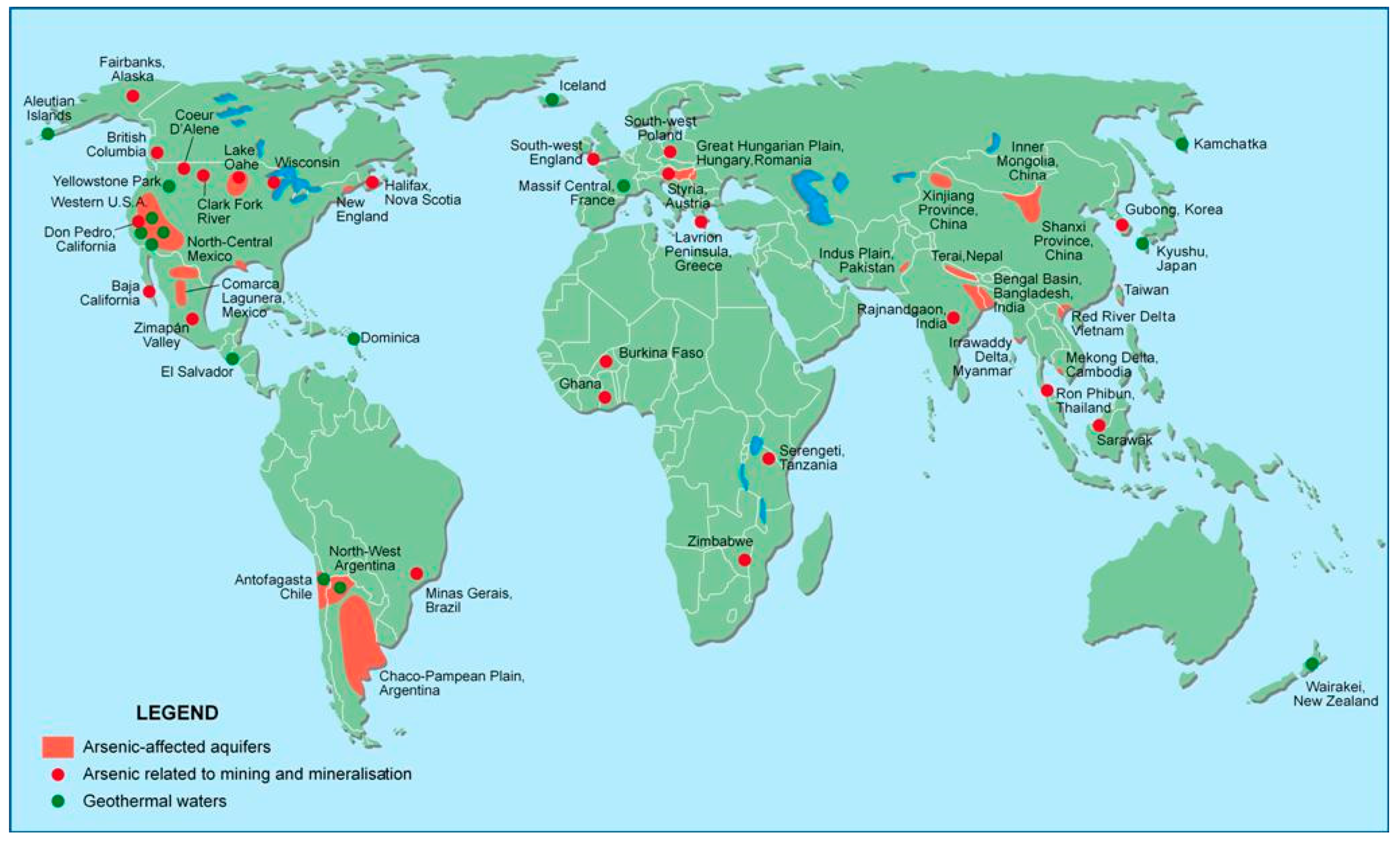
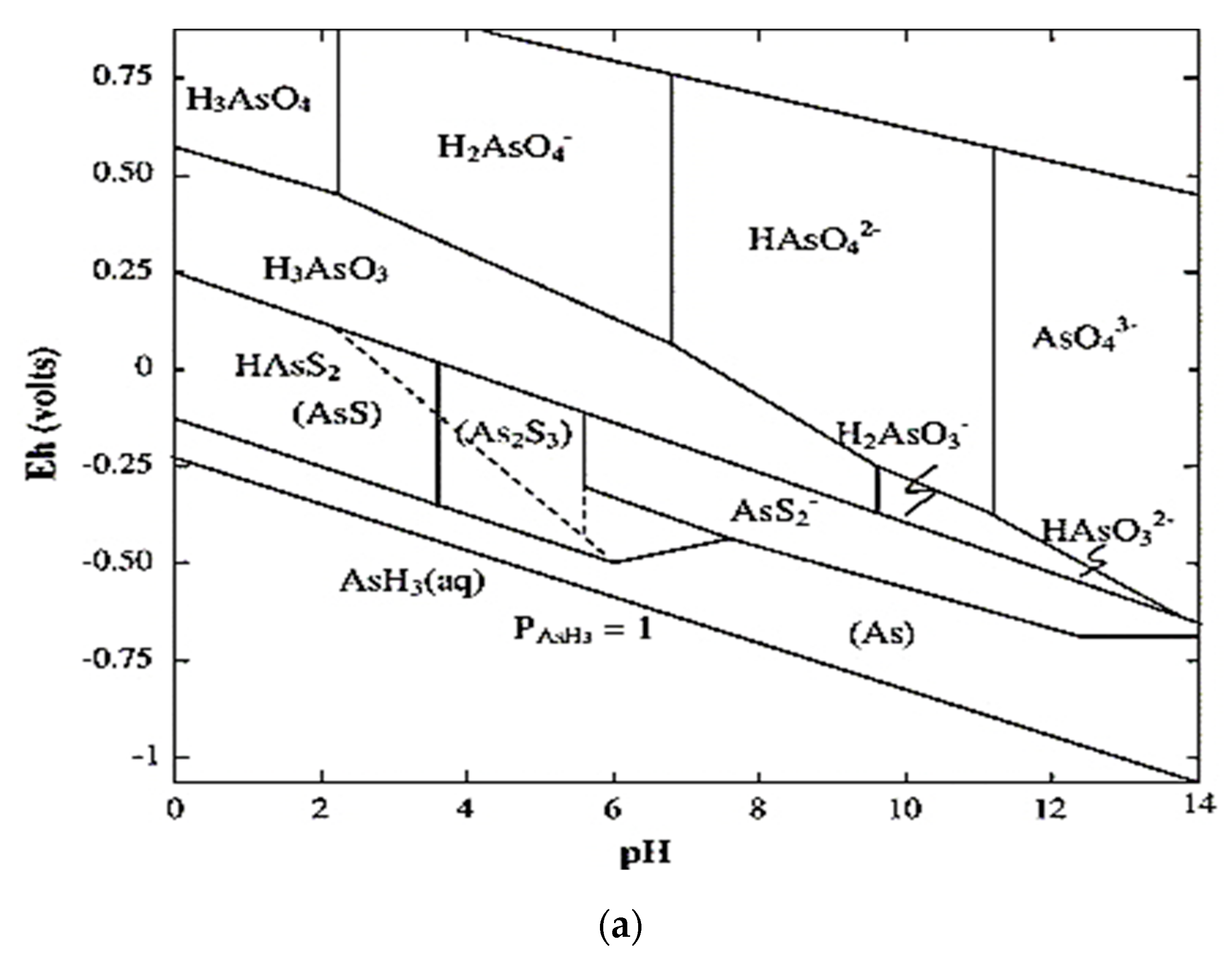
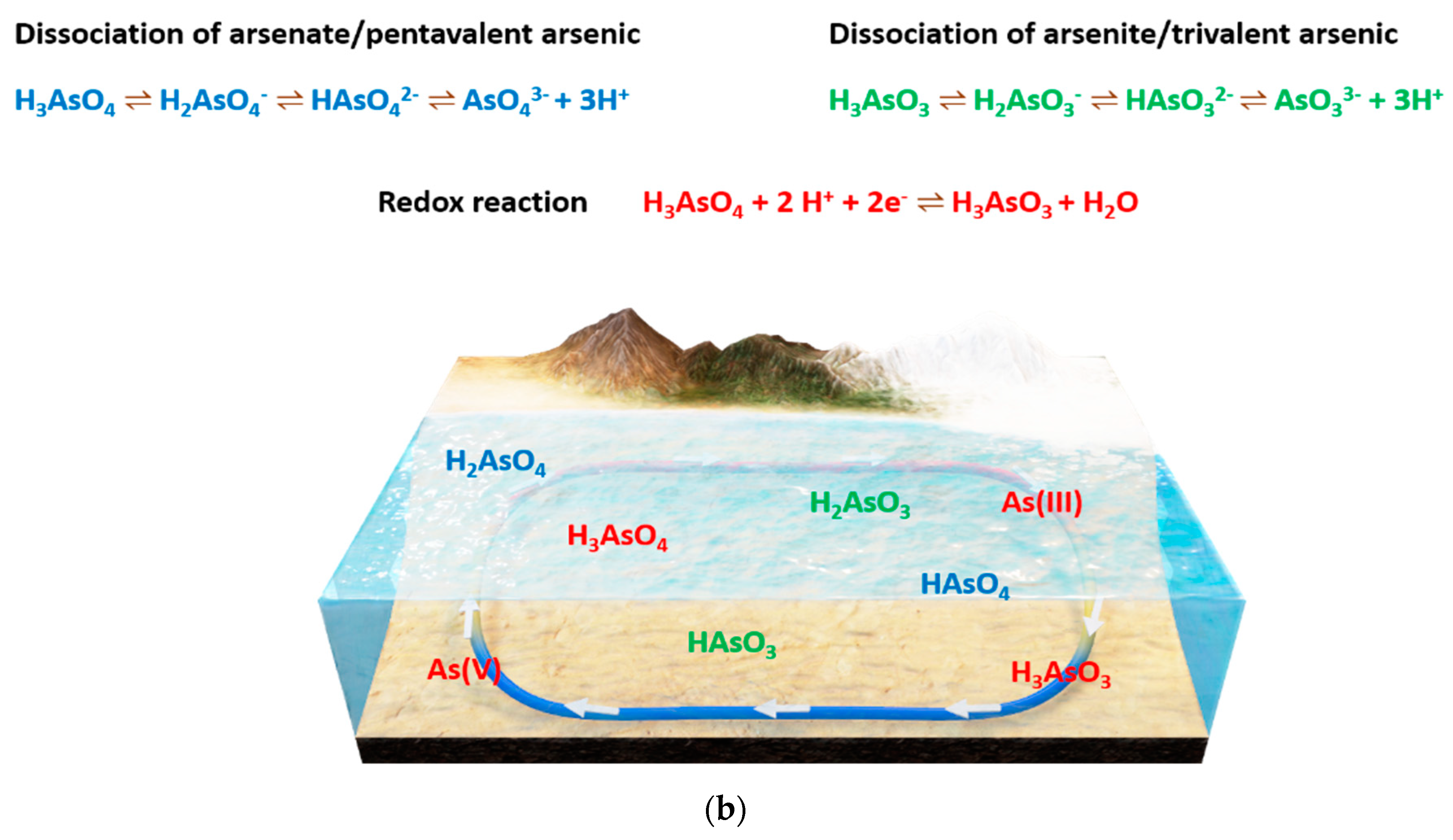
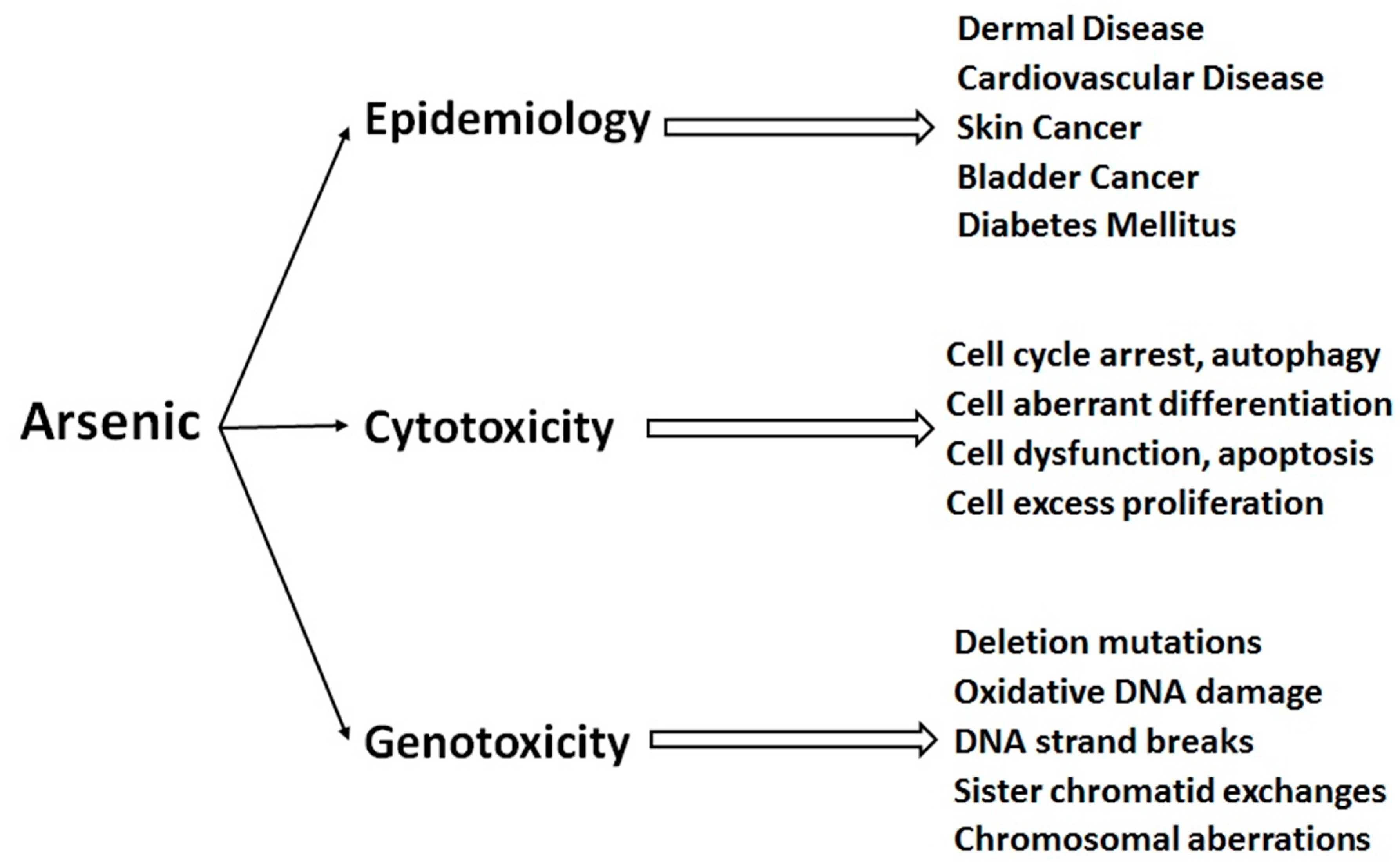

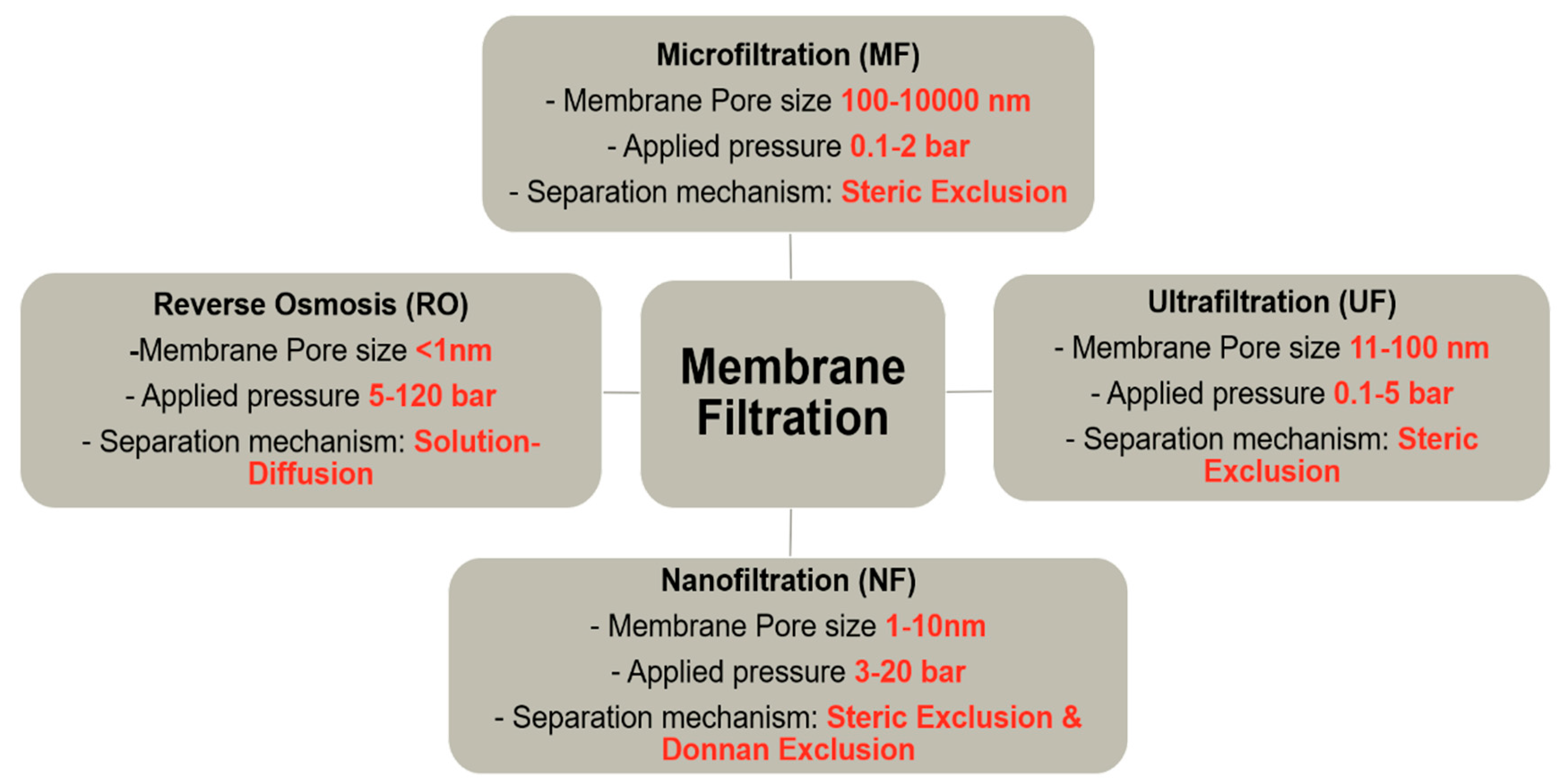
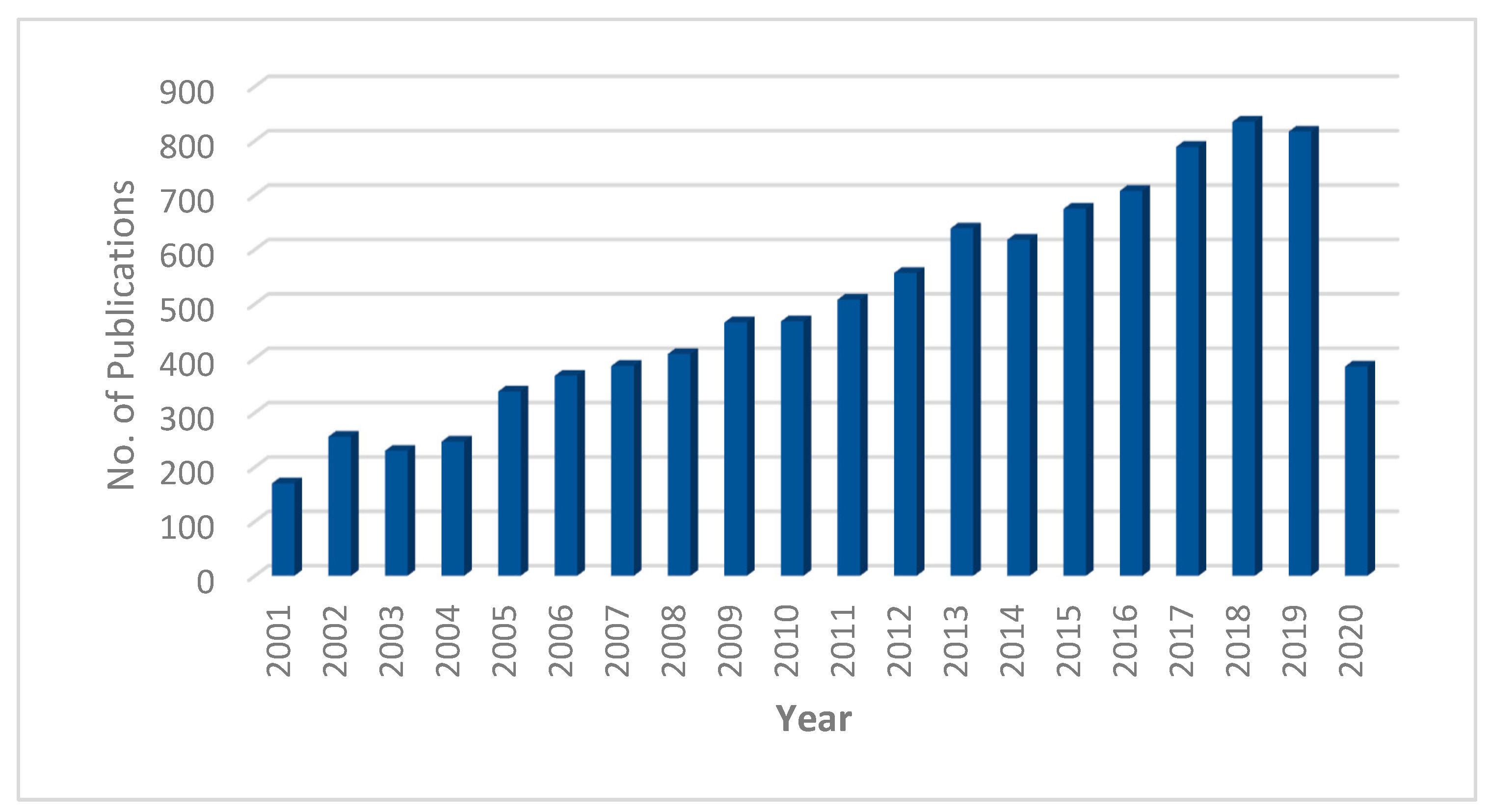
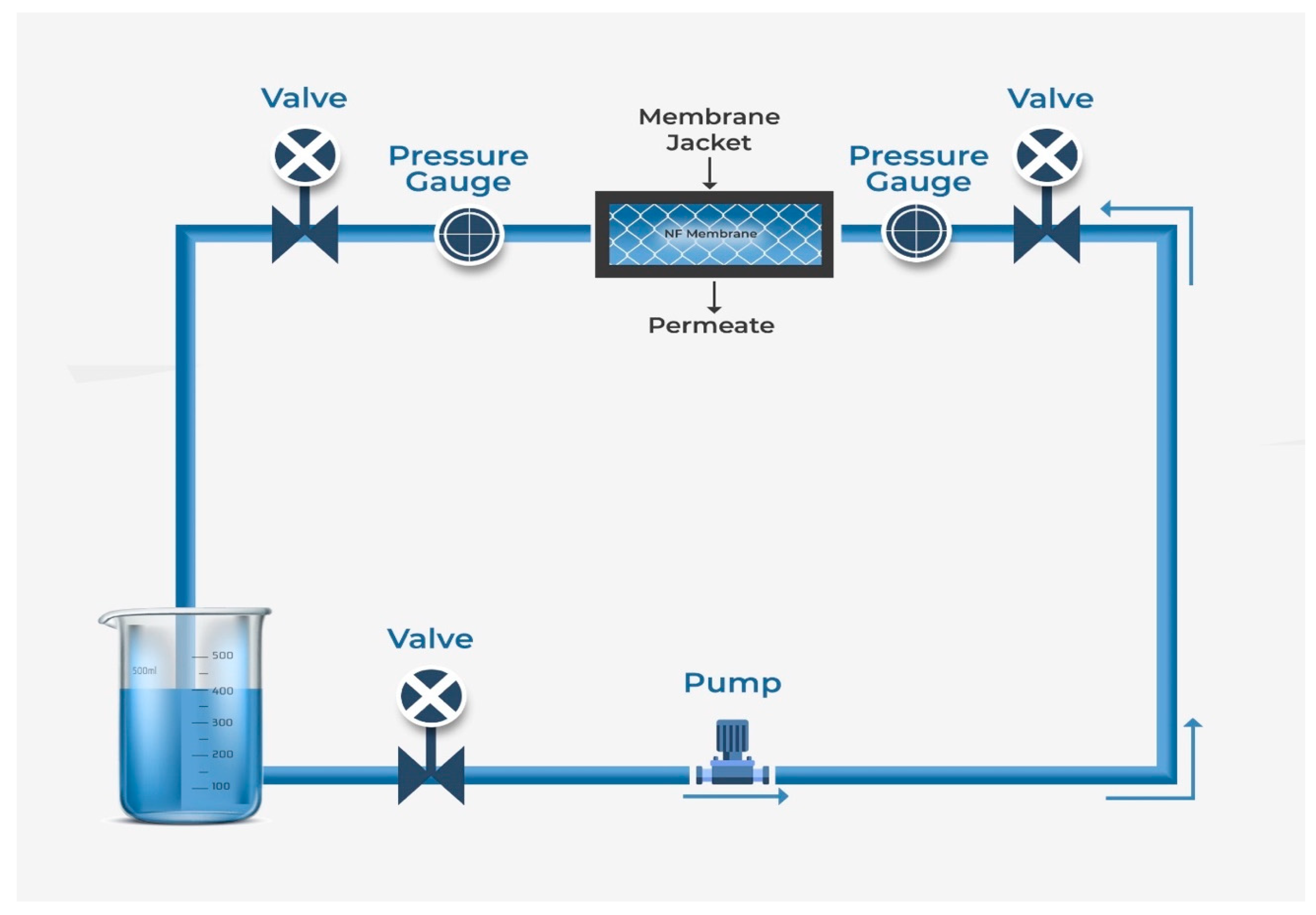
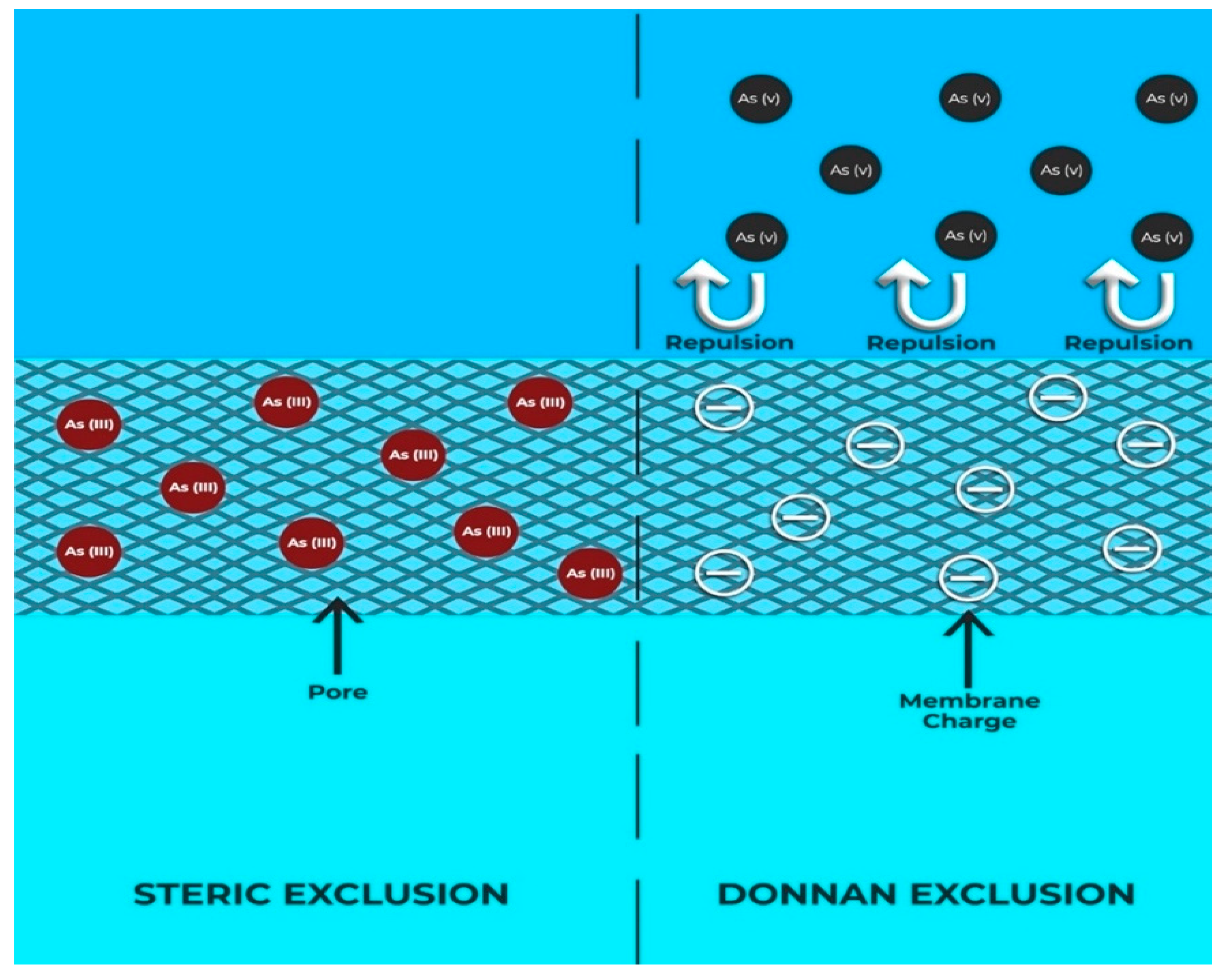
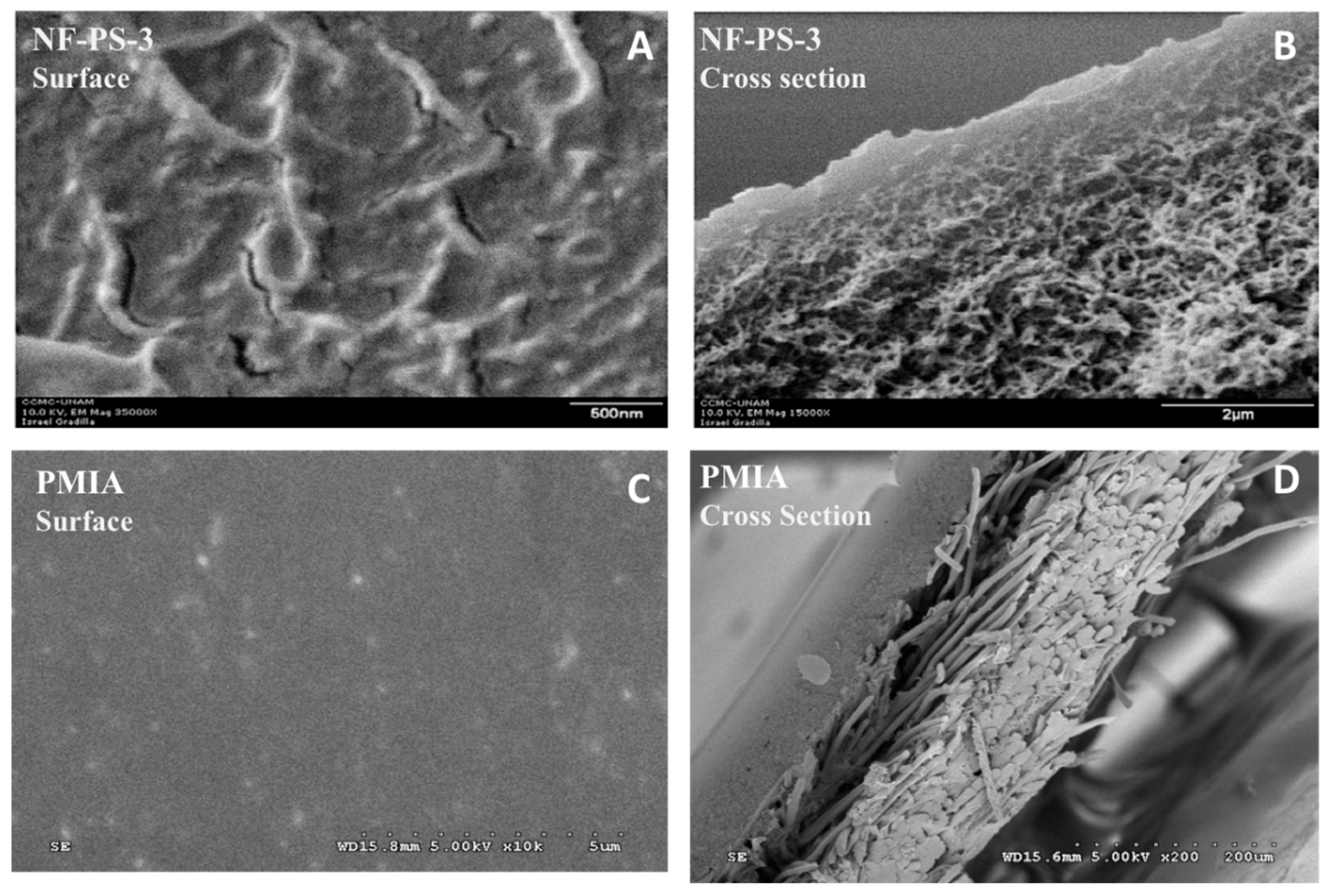
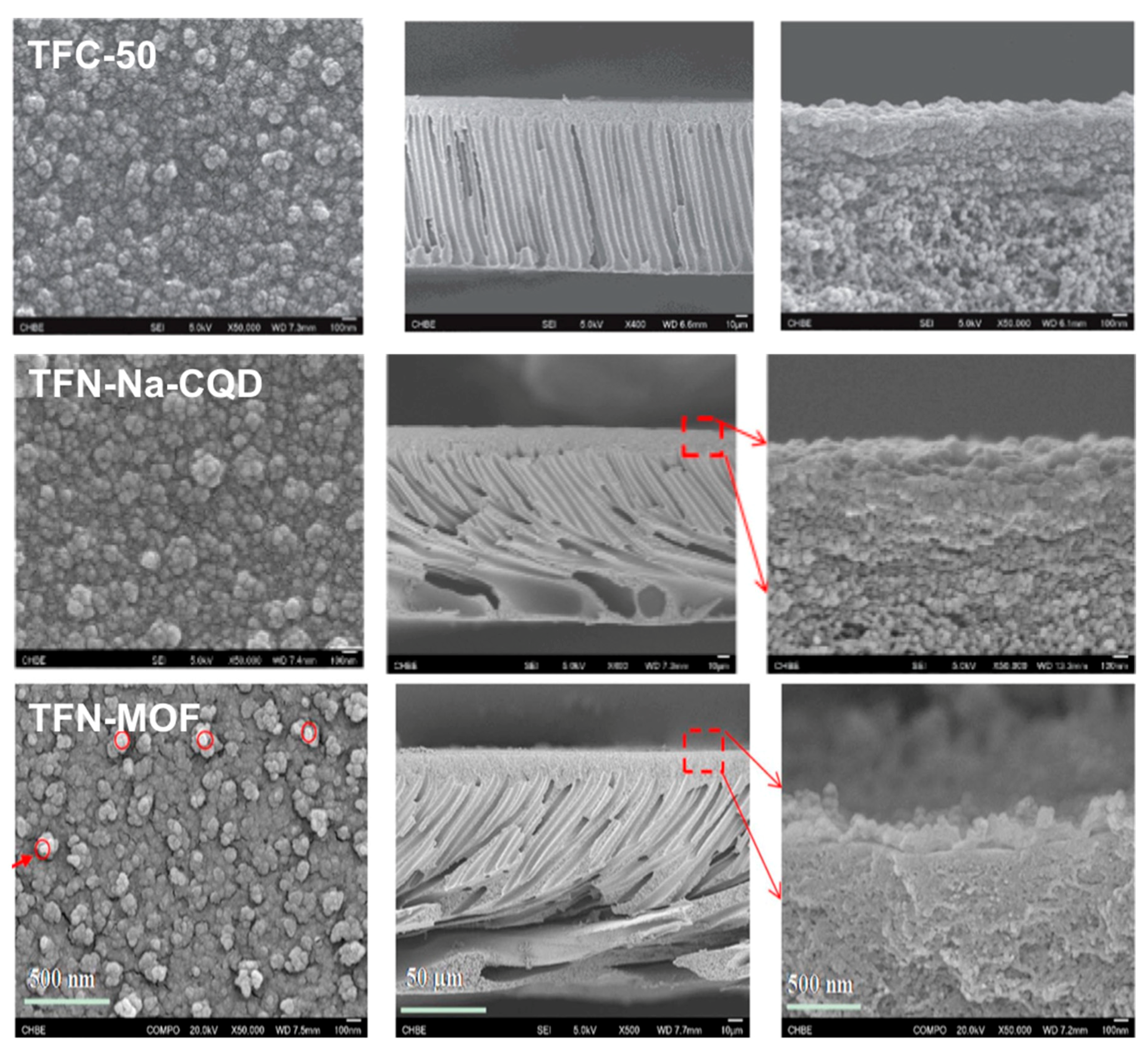
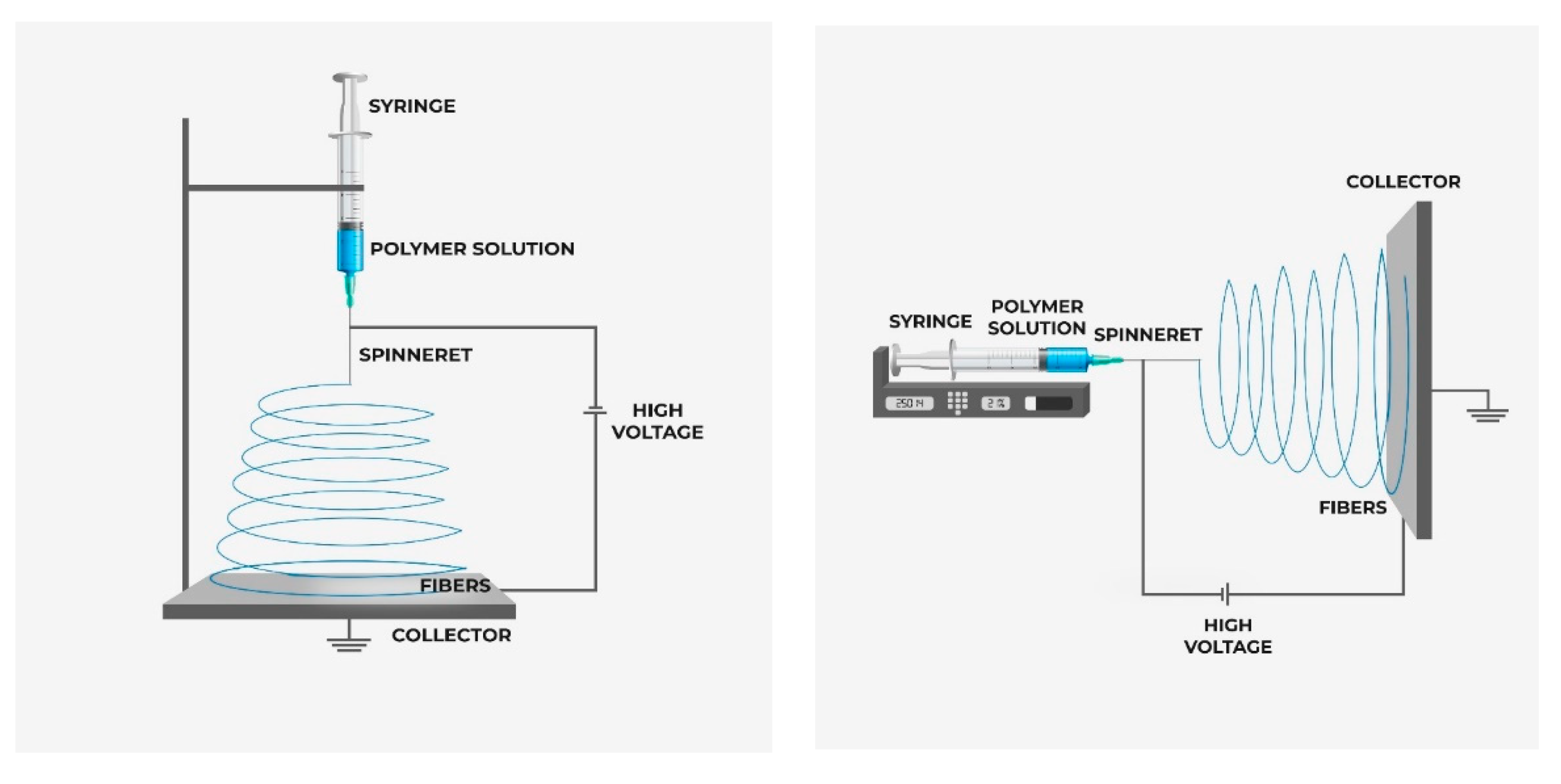
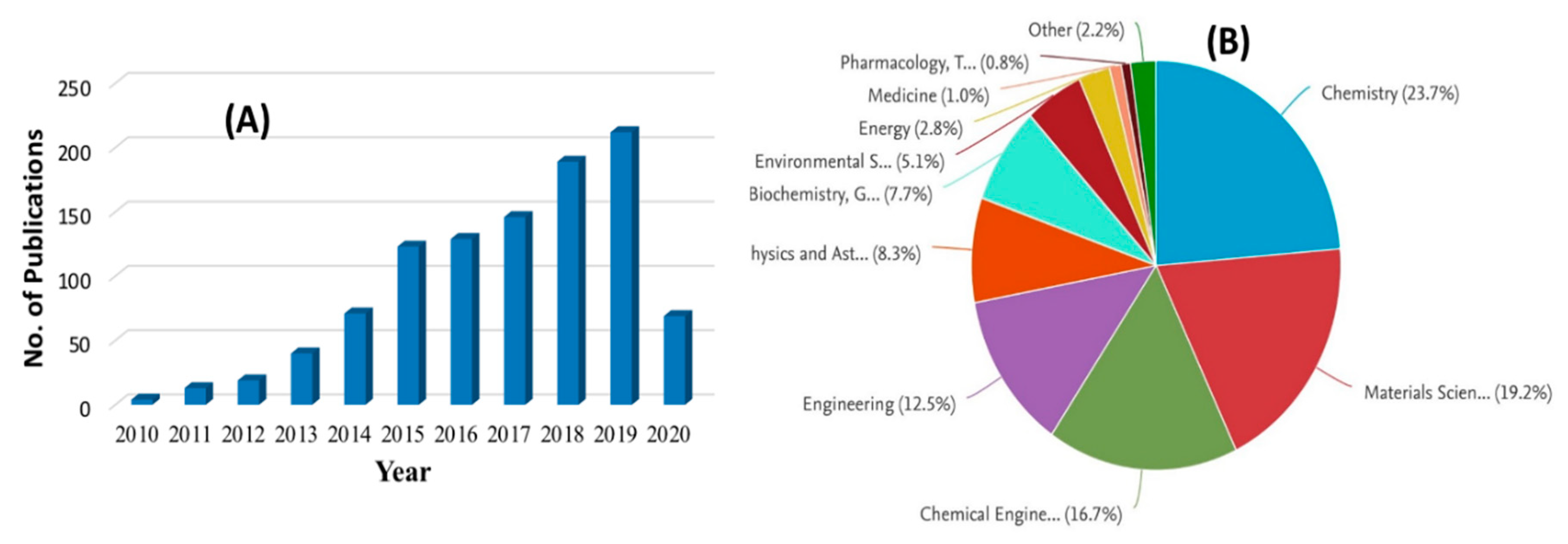
| Serial Number | Country | Region | Groundwater As Level (ppb) * | Permissible Limit (ppb) | References |
|---|---|---|---|---|---|
| 1 | Afghanistan | Ghazni | 10–500 | 10 (WHO) | [39] |
| 2 | Australia | Victoria (around the gold-mining regions) | 1–12 (Groundwater); 1–73 (Drinking-water); 1–220 (Surface water) | -- | [39,40,41] |
| 3 | Bangladesh | Noakhali | <1–4730 | 50 (WHO) | [39,42,43] |
| 4 | Brazil | Minas Gerais (Southeastern Brazil) | 0.4–350 (Surface water) | 10 (WHO) | [40,41,44] |
| 5 | Cambodia | Prey Veng and Kandal-Mekong delta | Up to 9001–1610 | 10 (WHO) | [39,45] |
| 6 | Canada | Nova Scotia (Halifax county) | 1.5–738.8 | 10 (WHO) | [39,40] |
| 7 | China | -- | 50–4440 | 50 (WHO) | [46] |
| 8 | Finland | Southwest Finland | 17–980 | 10 (WHO) | [40,41,44] |
| 9 | Greece | Fairbanks (mine tailings) | Up to 10,000 | 10 (WHO) | [36,39] |
| 10 | India | West Bengal & Uttar Pradesh | 10–3200 | 50 (WHO) | [36,39,41,47,48] |
| 11 | Japan | Fukuoka Prefecture (southern region) | 1–293 | 10 (WHO) | [40,41] |
| 12 | Mexico | Lagunera | 8–620 | 25 | [36,39,41] |
| 13 | Nepal | Rupandehi | Up to 2620 | 50 | [39,46] |
| 14 | Pakistan | Muzaffargarh (southwestern Punjab) | Up to 906 | 50 | [40,41,49] |
| 15 | Taiwan | -- | 10–1820 | 10 (WHO) | [36,39,41] |
| 16 | Thailand | Ron Phibun | 1–>5000 | 10 (WHO) | [36,39,41] |
| 17 | USA | Tulare Lake | Up to 2600 | 10 (USEPA) | [39,50,51] |
| 18 | Vietnam | Red River Delta (Northern Vietnam) Mekong Delta (Southern Vietnam) | <1–3050 | 10 (WHO) | [36,46] |
| Surface Water Area | Arsenic Contamination (µg L−1) | Ref. |
|---|---|---|
| Stampede and Slate Creek watersheds of USA and Alaska | 239 | [52] |
| Manchar Lake, Pakistan | 60.45 | [53] |
| Zenne River, Belgium | 0.97–3.6 | [54] |
| Alpine/Mediterranean Var River, France | 0.1–263 | [55] |
| Gomati river (Ganga Plain, northern India) | 1.29–9.62 | [56] |
| Arsenic Removal Technology | Advantages | Disadvantages | Removal Efficiency of As(v) (%) | References |
|---|---|---|---|---|
| Oxidation | -Low operating cost. -Works over a wide pH range. | -Very slow process. -Drinking water has bad smell and color in addition of chlorine, permanganate, etc. -Sludge formation. | >95 | [39,68,75,76,77,78,79,80,81,82,83,84,85,86,87,88] |
| Coagulation | -It can be operated within a wide range of pH. | -Pre-oxidation of arsenite required. -High arsenic contaminated sludge production. -Expensive process. -Additional filtration required. | >90 | [84,89,90,91,92,93,94,95] |
| Adsorption | -Low cost. -Ease of operation. | -pH, effective surface area, and the nature of the adsorbent need to be maintained. -Arsenite cannot be removed very well. -Post-filtration required. -Organic matter, other salts in water decreases the efficiency of the process. -Removal of the generated heavy flocs are difficult. | 100 | [24,94,96,97,98,99,100,101,102,103,104,105,106,107] |
| Ion Exchange Process | -pH independent process. -Only efficient for the arsenite removal. | -Only efficient for the arsenite removal. -Expensive process. -Low capacity. -Sludge disposal problem. -Resin needs to be replaced again and again. | 95 | [94,106,108] |
| Electrocoagulation | -Less area requirement. -Sustainable technology. | -Sludge production. -High investment cost. -High energy consumption. | >99 | [72,109,110,111,112,113,114,115] |
| Membrane Filtration | -Easy operational -technique. -High arsenate removal efficiency. -No sludge production. | -Membrane fouling. -High investment cost. | >99 | [89,106,116,117,118,119,120,121,122,123,124,125,126] |
| NF Membrane | Materials | Arsenic Rejection (%) | References | |
|---|---|---|---|---|
| Arsenate | Arsenite | |||
| Commercial NF Membranes | ||||
| NF-45 | Porous polyamide thin-film nanocomposite (TFC) membrane | 90 | 10–20 | [149] |
| ES-10 | Aromatic polyamide | 87–93 | 50–89 | [150] |
| NTR-7450 | Sulfonated polyethersulfone | 80.5–84.5 | --- | [151] |
| UTC-70 | Polypiperazine-amide | >95 | --- | [151] |
| NF-300 | TFC polyamide | 60–99 | --- | [152] |
| NF-1, NF-2 and NF-20 | TFC polyamide | 50–100 | --- | [153] |
| NF-300 | TFC polyamide | >95 | --- | [154] |
| ESNA-1-LF | Composite Polyamide | >94 | --- | [155] |
| HODRA-CORE | Sulfonated polyethersulfone | <47 | --- | [155] |
| NF-1 | Aromatic polyamide | 93–98 | --- | [156] |
| --- | TFC membrane with aromatic polyamide Selective layer | 40 | --- | [157] |
| --- | Aromatic Polyamide and a polysulphone sublayer supported by nonwoven polyester structure | 92–94 | --- | [158] |
| DL/DK | Polyamide layers on polyester and polysulfone support | 55.8–76.2 | --- | [159] |
| NF90-4040 | Polyamide TFC | 94 | 90 | [160] |
| Dow/FilmTec NF90 | Polyamide | 98 | --- | [161] |
| Dow/FilmTec NF270 | Polyamide | 94 | --- | [161] |
| FilmTec NF45 | Aromatic Polyamide TFC | 60–90 | --- | [162] |
| FilmTec NF70 | TFC membrane | 97 | --- | [121] |
| Synthesized NF Membranes | ||||
| NF-PS-3 | Microporous polysulfone membrane | 98.5 | 70.4 | [163] |
| PMIA | Poly m–phenylene isophthalamide | >90 | --- | [164] |
| SPEEK | Sulfonated poly(ether ether ketone) | >95 | --- | [165] |
| TFN | 0.15 wt% UiO-66 (MOF) | 98.6 | --- | [166] |
| TFN-0.05 | 0.05 wt% sodium ion modified carbon quantum dot (Na-CQD) incorporated thin-film nanocomposite | 99.5 | --- | [167] |
| TFC-50 | 50 wt% P[MPC-co-AEMA] co-polymer incorporated into polyamide selective layer of TFC membranes | 99.8 | --- | [168] |
| PA-CSBF | Polyamide intercalated nanofiltration membrane modified with biofunctionalized core shell composite | --- | 99 | [169] |
| AAF–NF | TFN nanofiltration membranes with aromatic amine-functionalized multiwalled carbon nanotubes | 91 | --- | [170] |
| AF–NF | TFN nanofiltration membranes with aliphatic amine-functionalized multiwalled carbon nanotubes | >72 | --- | [170] |
| NF Membrane | Arsenic Rejection (%) | References | |||
|---|---|---|---|---|---|
| Arsenate [AsV] | Arsenite [AsIII] | ||||
| Effect of arsenic concentration of feed water | |||||
| BQ01 | 60 at 10 µg/L | 90 at 316 µg/L | 28 at 10 µg/L | 5 at 316 µg/L | [212] |
| NF-300 | 86 at 80 µg/L | 99 at 370 µg/L | --- | [213] | |
| NF-90 | Unaffected | 53 at 50 µg/L | 59 at 250 µg/L | [162] | |
| NF-200 | Unaffected | 23 at 50 µg/L | 25 at 250 µg/L | [162] | |
| --- | 90 at 20 µg/L | 100 at 90 µg/L | 9.8 at 20 µg/L | 2.0 at 90 µg/L | [214] |
| NE 90 | 90 at 20 µg/L | 96 at 100 µg/L | 44 at 20 µg/L | 40 at 100 µg/L | [215] |
| NF-PS-3 | 88.3 at 50 ppb | 97.3 at 1000 ppb | 32.6 at 50 ppb | 51.8 at 1000 ppb | [163] |
| NF-90 | 97 at 100 ppb | 99 at 1000 ppb | --- | [216] | |
| N30F | 79 at 100 ppb | 74 at 1000 ppb | --- | [216] | |
| NTR-7450 | 80.5 at 30 µg/L | 84.5 at 150 µg/L | --- | [151] | |
| UTC-70 | 95 at 30 µg/L | 99 at 150 µg/L | --- | [151] | |
| NF90-4040 | 93 at 100 µg/L | 90 at 1000 µg/L | 90 at 100 µg/L | 82 at 1000 µg/L | [160] |
| Effect of pH of feed water | |||||
| NF-45 | 25% at pH 4 | >80% at pH 9 | Unaffected | [162] | |
| BQ01 | 8% at pH 4.5 | 85% at pH 8.5 | Unaffected | [212] | |
| NE 90 | 80% at pH 4 | 98% at pH 10 | 40% at pH 8 | 65% at pH 10 | [215] |
| NF-PS-3 | 72.3% at pH 3 | 98.5% at pH 10 | 53% at pH 3 | 80.6% at pH 10 | [163] |
| N30F | 74% at pH 3.4 | 88% at pH 10 | --- | --- | [216] |
| NF-90 | 94% at pH 3.4 | 98.4% at pH 10 | --- | --- | [216] |
| NTR-7450 | 61% at pH 3 | 84% at pH 11 | 13% at pH 3 | 55% at pH 11 | [151] |
| UTC-70 | 91% at pH 3 | 99.2% at pH 11 | 70% at pH 3 | 92% at pH 11 | [151] |
| NF-1 | 87% at pH 3 | 99% at pH 10 | 50% at pH 3 | 76% at pH 10 | [153] |
| NF-2 | 82% at pH 3 | 96% at pH 10 | 33% at pH 3 | 69% at pH 10 | [153] |
| NF-20 | 86% at pH 3 | 98% at pH 10 | 43% at pH 3 | 71% at pH 10 | [153] |
| Alfa Laval NF | 80% at pH 6 | 92% at pH 8 | --- | --- | [217] |
| Dow NF270 | 87% at pH 6 | 89% at pH 8 | --- | --- | [217] |
| PMIA | 83% at pH 3 | 99% at pH 9 | --- | --- | [164] |
| SPEEK | 89% at pH 4 | 96.4% at pH 9 | --- | --- | [165] |
| Effect of applied pressure | |||||
| NF-70 | 97.3 at 0.4 MPa | 97.5 at 0.8 MPa | 96.1 at 0.4 MPa | 96.3 at 0.8 MPa | [121] |
| ES-10 | 95 at 0.3 MPa | 97.5 at 1.1 MPa | 60 at 0.3 MPa | 80 at 1.1 MPa | [218] |
| NTR-729HF | 91 at 0.3 MPa | 94 at 1.1 MPa | 10 at 0.3 MPa | 24 at 1.1 MPa | [218] |
| NTR-7250 | 85.5 at 0.3 MPa | 86 at 1.1 MPa | 8 at 0.3 MPa | 15 at 1.1 MPa | [218] |
| NF-300 | 92 at 0.31 MPa | 94 at 0.724 MPa | --- | [213] | |
| NF-90 | Unaffected | 50 at 5 bar | 63 at 20 bar | [219] | |
| NF-200 | Unaffected | 16 at 5 bar | 30 at 20 bar | [219] | |
| NF-PS-3 | Unaffected | 41 at 80 psi | 56.5 at 180 psi | [163] | |
| NF-300 | 90 at 10 bar | 99 at 50 bar | --- | [220] | |
| NTR-7450 | 74 to at 0.2 MPa | 82.5 at 1.0 MPa | 13.5 at 0.2 MPa | 21.5 at 1.0 MPa | [151] |
| UTC-70 | 95 at 0.2 MPa | 99.2 at 1.0 MPa | 70 at 0.2 MPa | 80.5 at 1.0 MPa | [151] |
| NF90-4040 | 86 at 4 bar | 94 at 7 bar | 82 at 4 bar | 89 at 7 bar | [160] |
| Effect of temperature | |||||
| NF-70 | 97.5 at 15 °C | 97 at 25 °C | 96 at 15 °C | 96.5 at 25 °C | [121] |
| NF-90 | 99.9 at 15 °C | 98.6 at 35 °C | --- | [219] | |
| NF-200 | 98.5 at 15 °C | 96.9 at 35 °C | --- | [219] | |
| NF-90 | 95.4 at 15 °C | 93.1 at 40 °C | --- | [216] | |
| N30F | 86 at 15 °C | 72 at 40 °C | --- | [216] | |
| NF90-4040 | 87 at 28 °C | 82 at 37 °C | 86 at 28 °C | 81 at 37 °C | [160] |
© 2020 by the authors. Licensee MDPI, Basel, Switzerland. This article is an open access article distributed under the terms and conditions of the Creative Commons Attribution (CC BY) license (http://creativecommons.org/licenses/by/4.0/).
Share and Cite
Siddique, T.; Dutta, N.K.; Roy Choudhury, N. Nanofiltration for Arsenic Removal: Challenges, Recent Developments, and Perspectives. Nanomaterials 2020, 10, 1323. https://doi.org/10.3390/nano10071323
Siddique T, Dutta NK, Roy Choudhury N. Nanofiltration for Arsenic Removal: Challenges, Recent Developments, and Perspectives. Nanomaterials. 2020; 10(7):1323. https://doi.org/10.3390/nano10071323
Chicago/Turabian StyleSiddique, TA, Naba K. Dutta, and Namita Roy Choudhury. 2020. "Nanofiltration for Arsenic Removal: Challenges, Recent Developments, and Perspectives" Nanomaterials 10, no. 7: 1323. https://doi.org/10.3390/nano10071323
APA StyleSiddique, T., Dutta, N. K., & Roy Choudhury, N. (2020). Nanofiltration for Arsenic Removal: Challenges, Recent Developments, and Perspectives. Nanomaterials, 10(7), 1323. https://doi.org/10.3390/nano10071323






